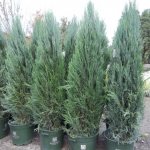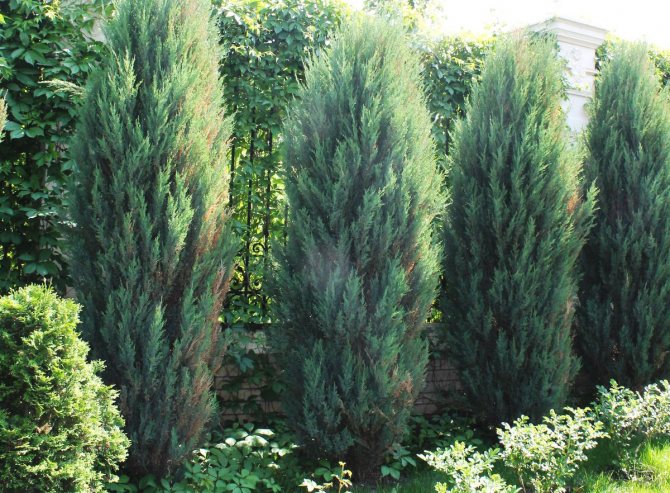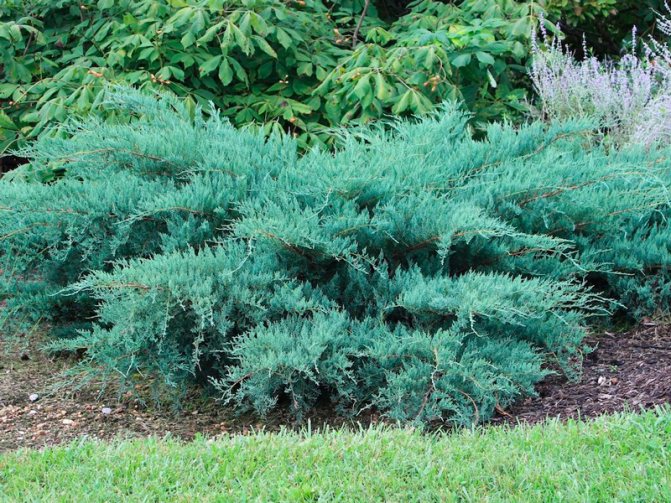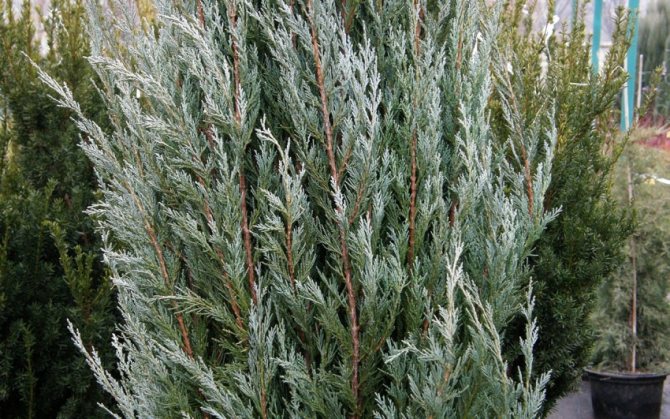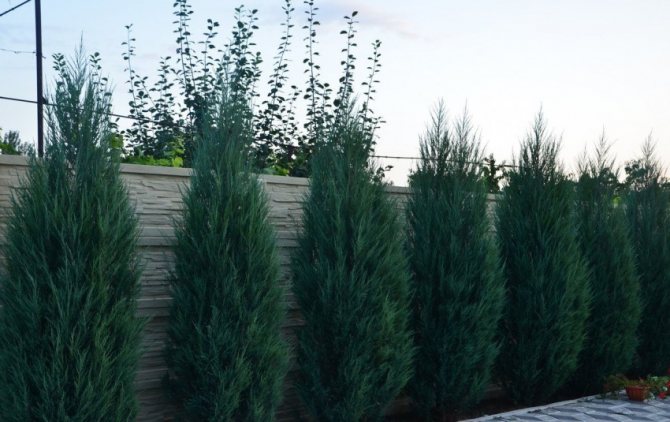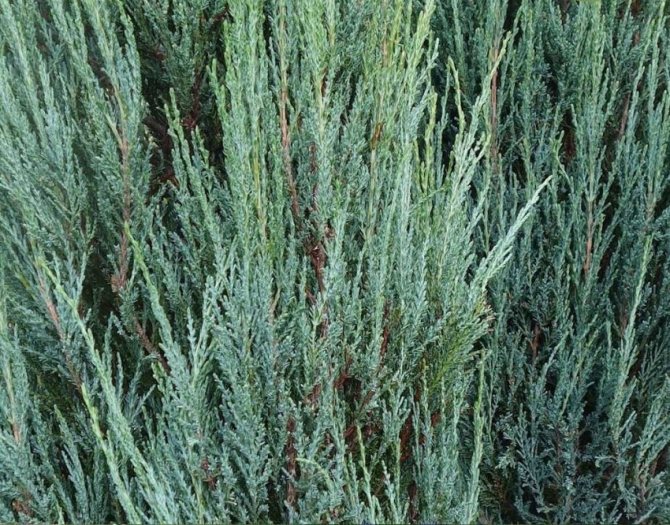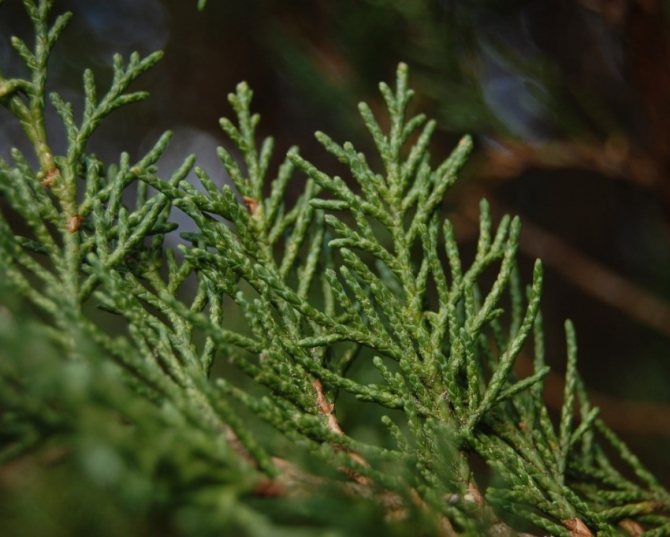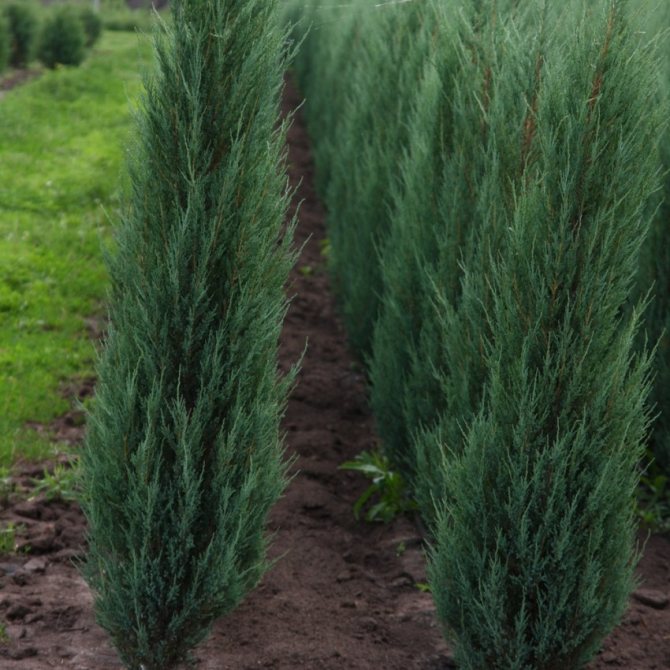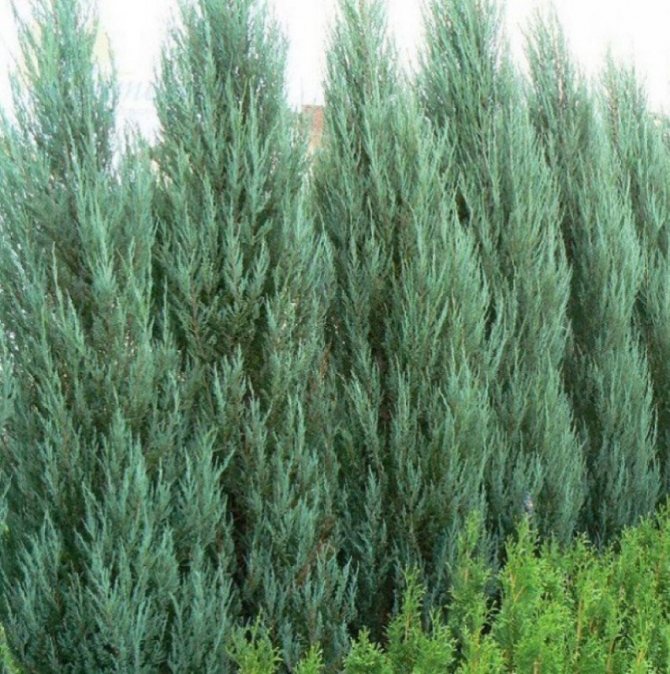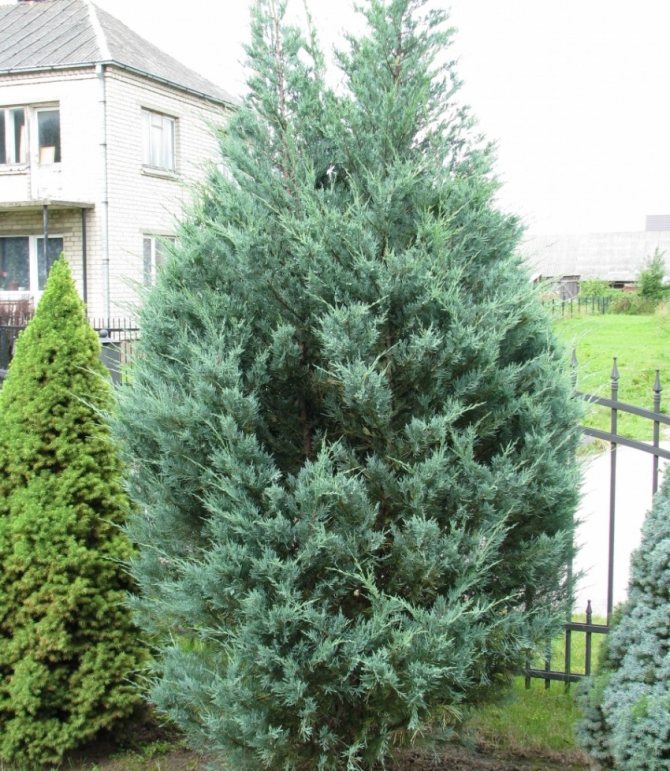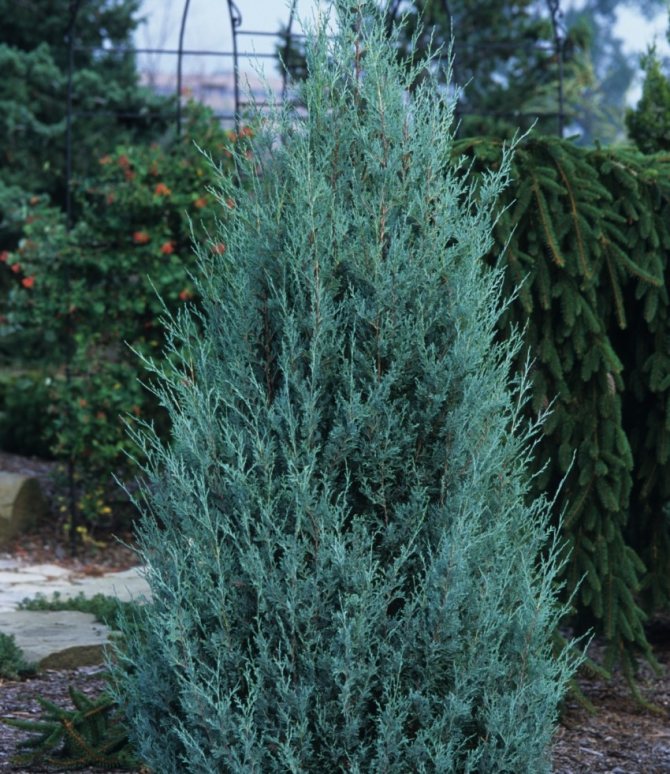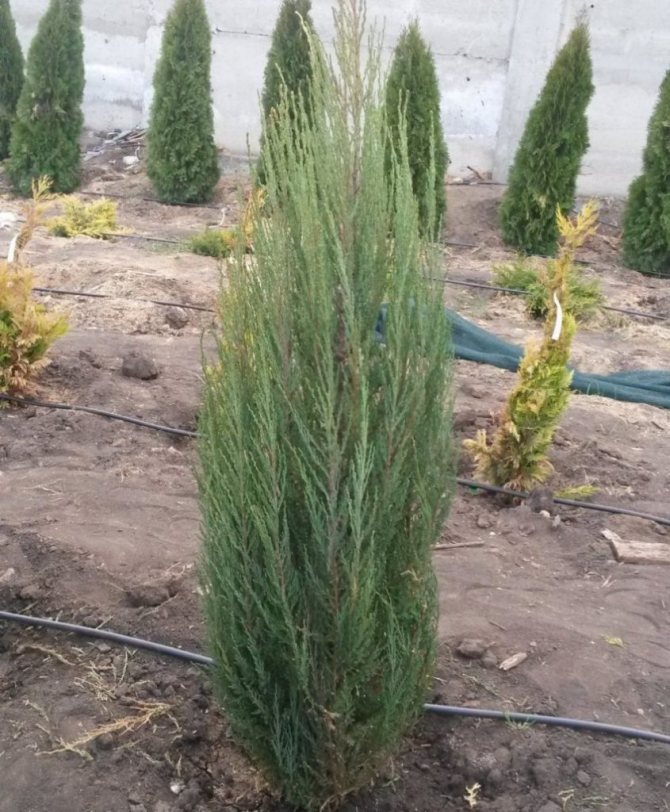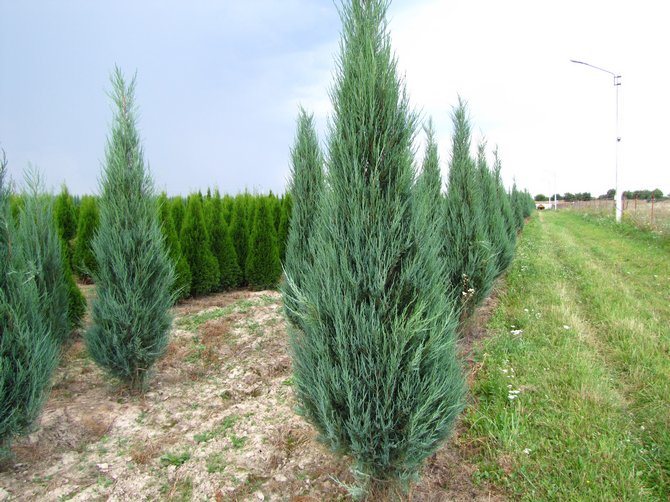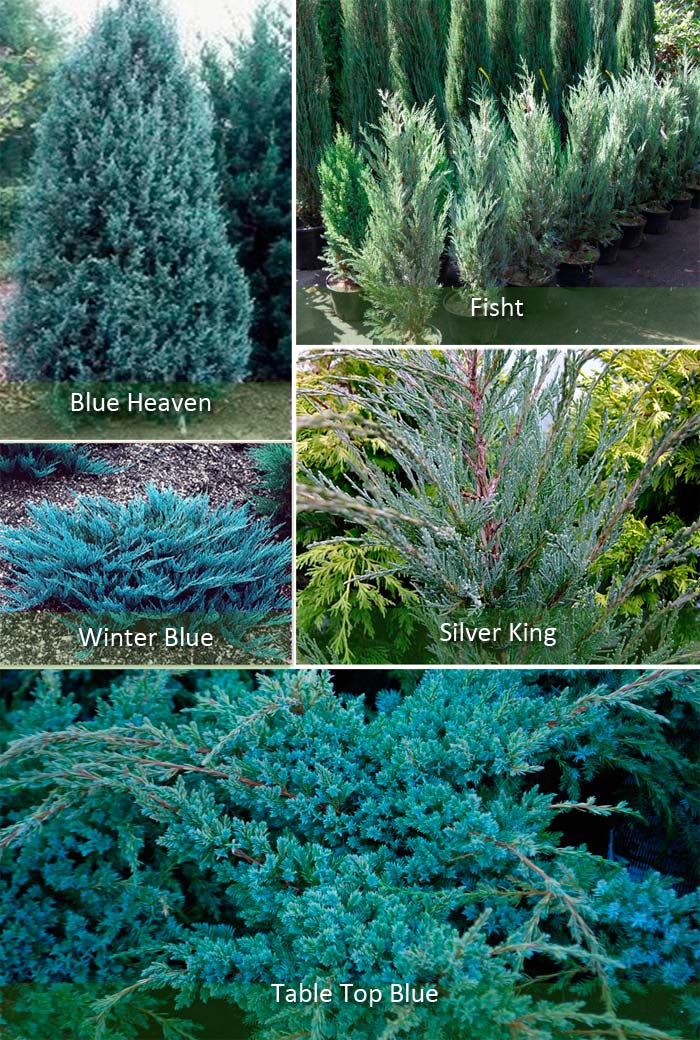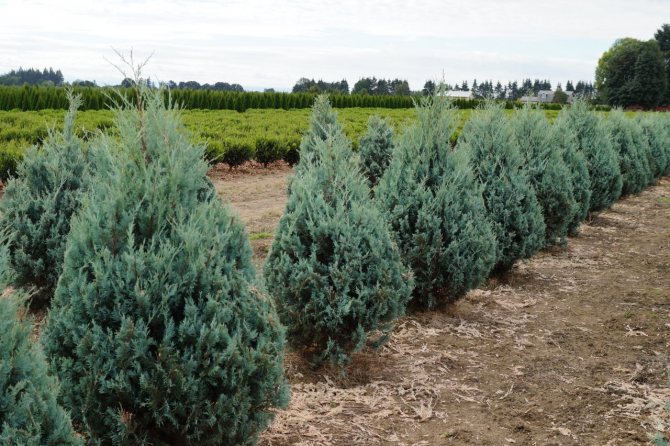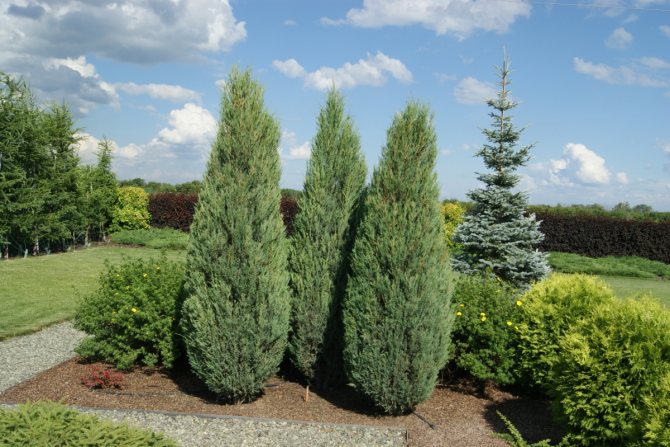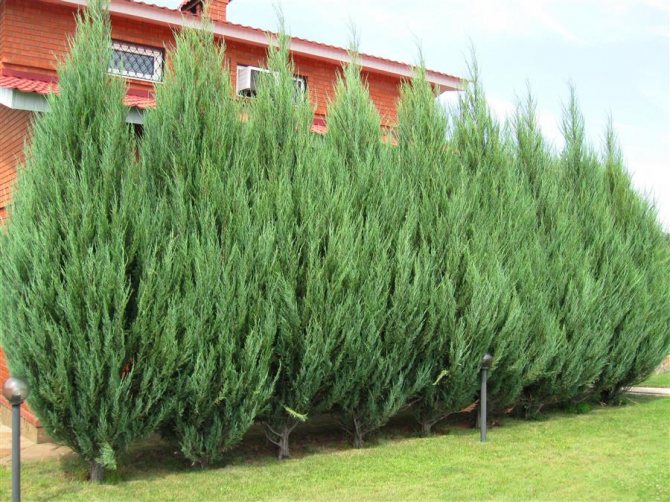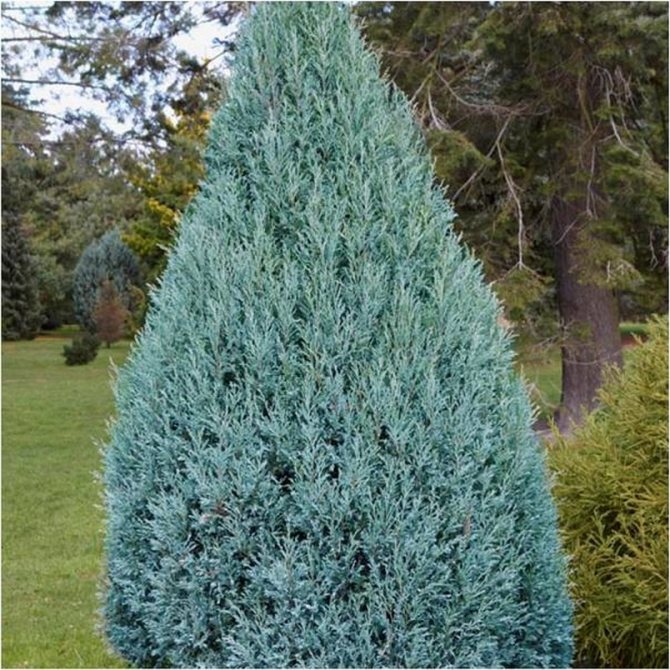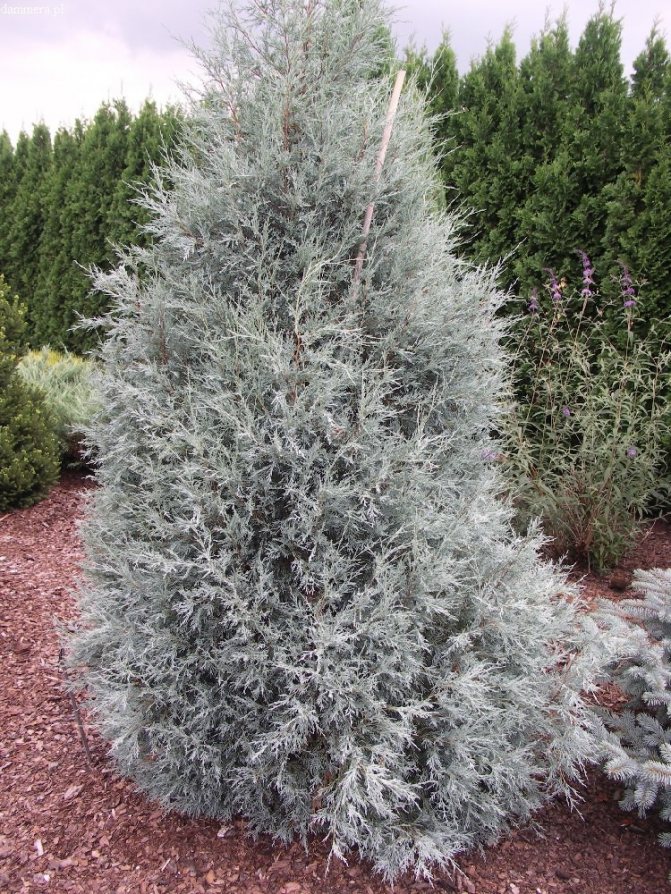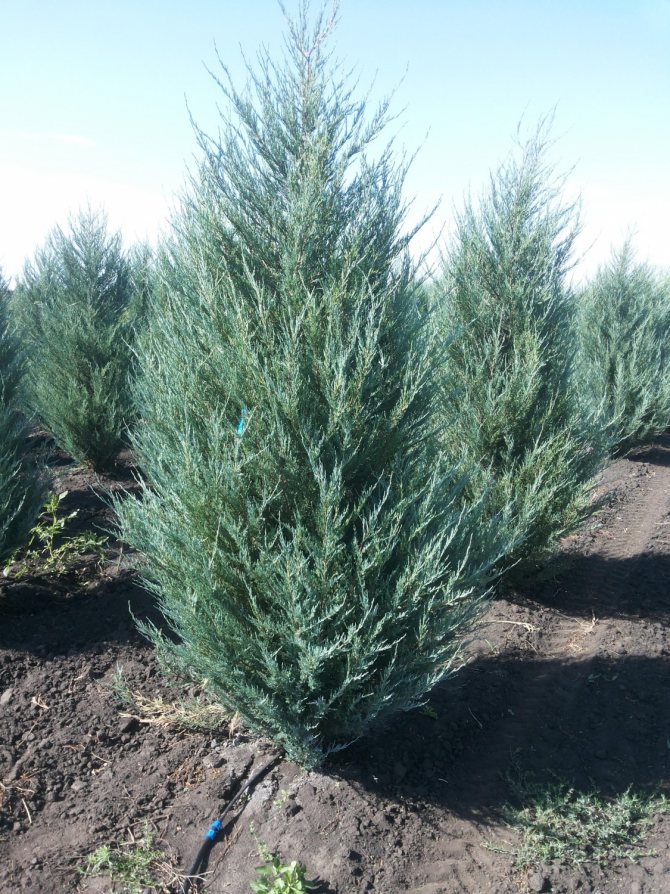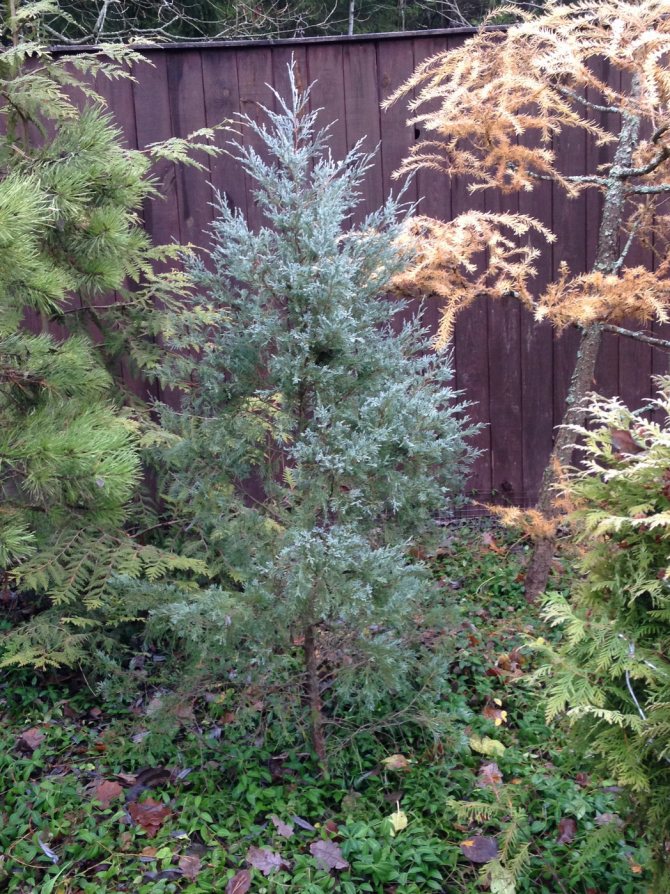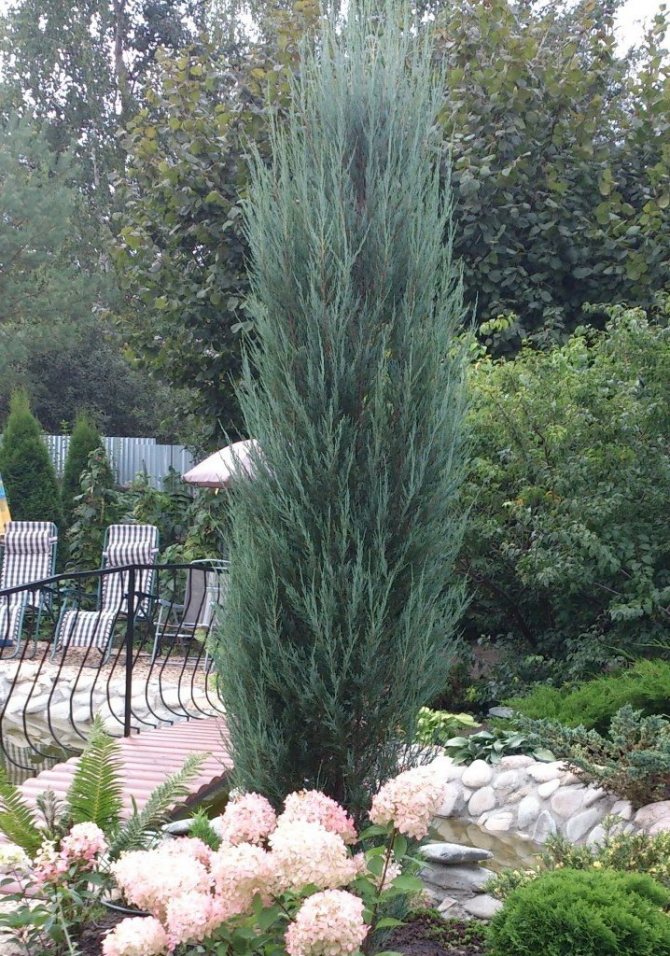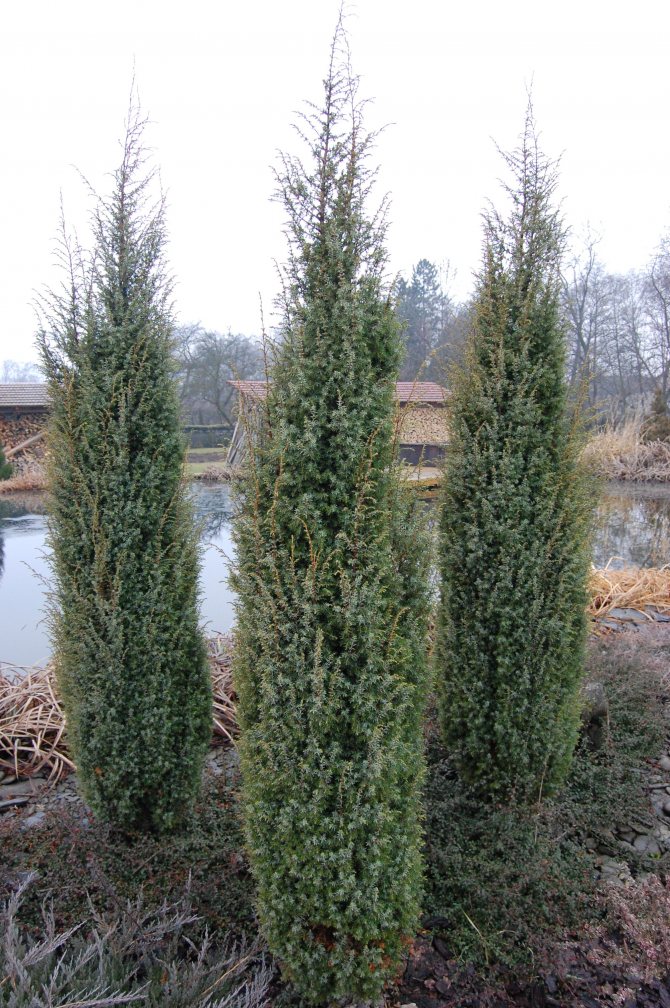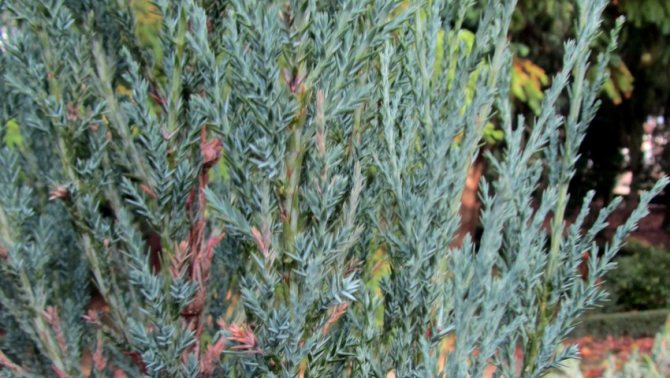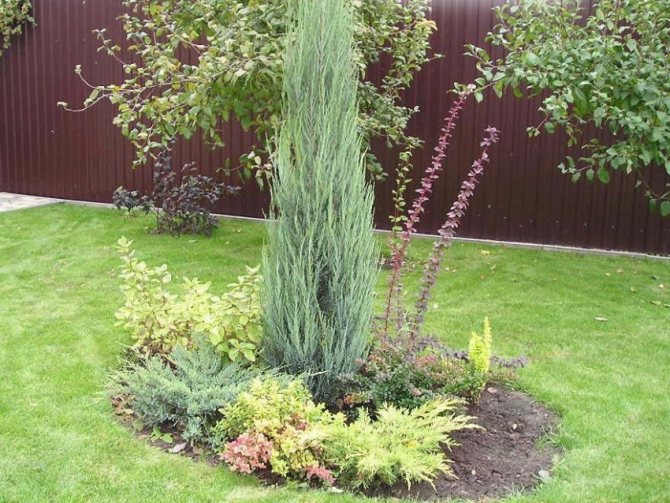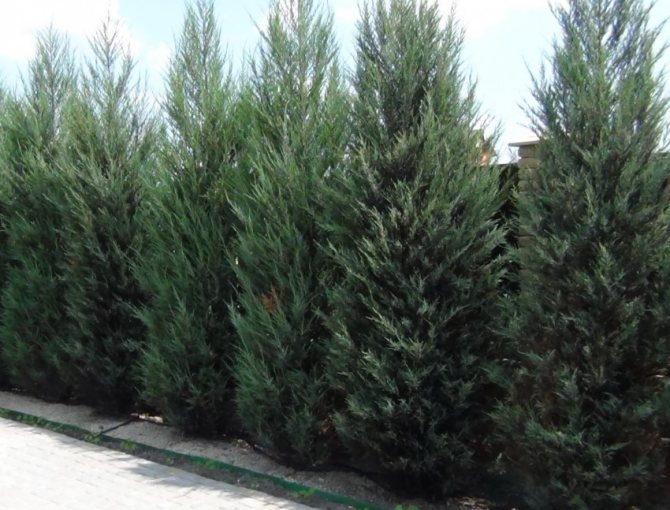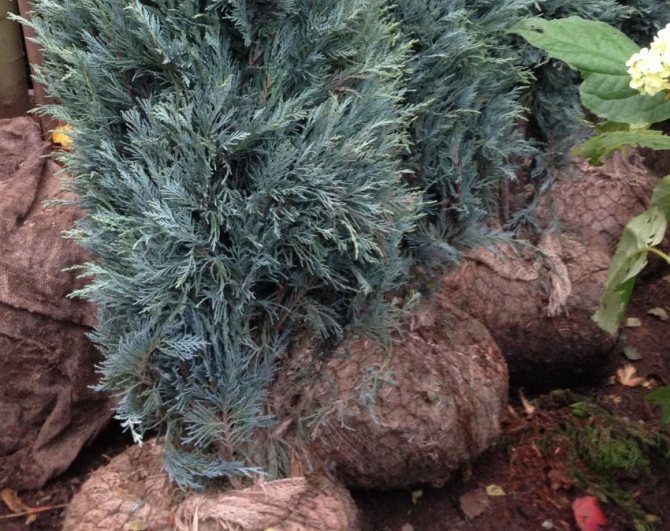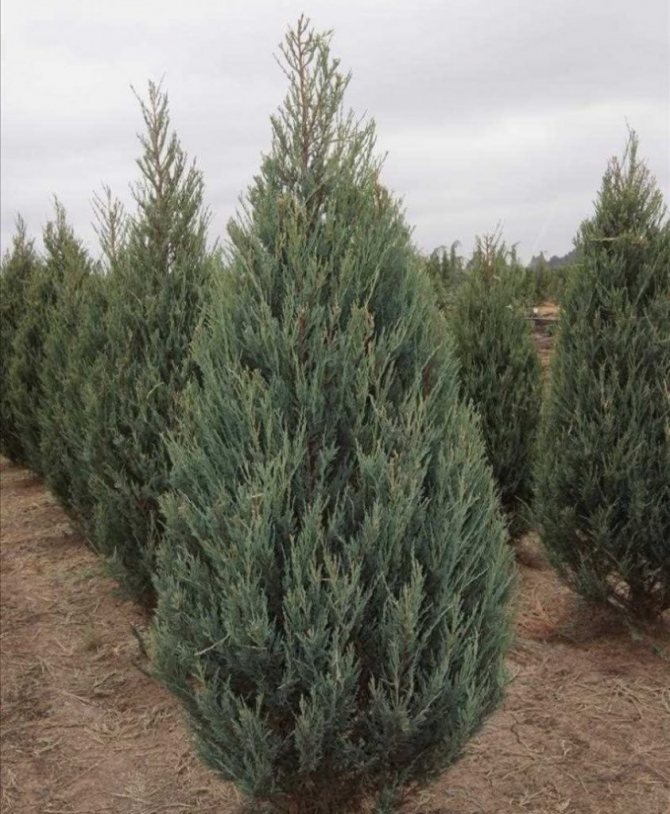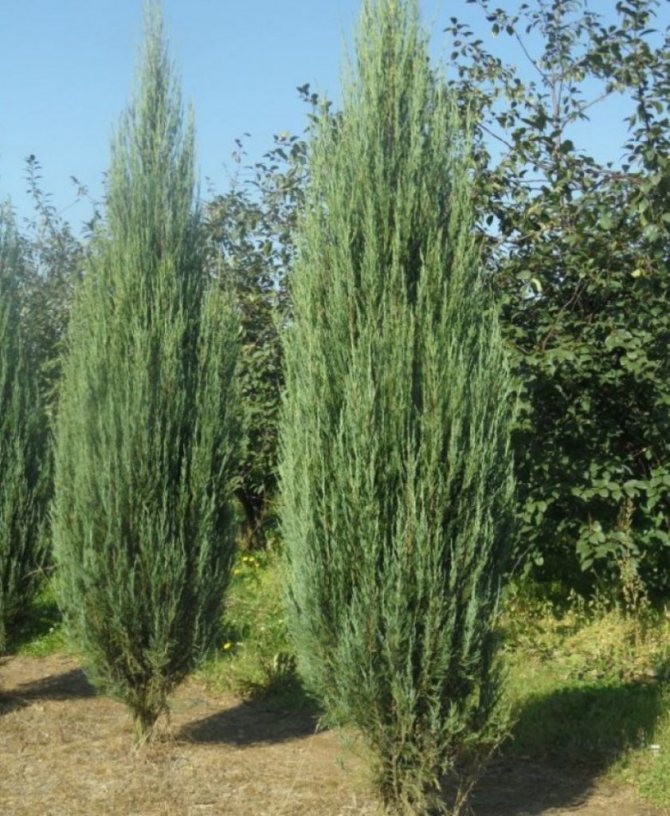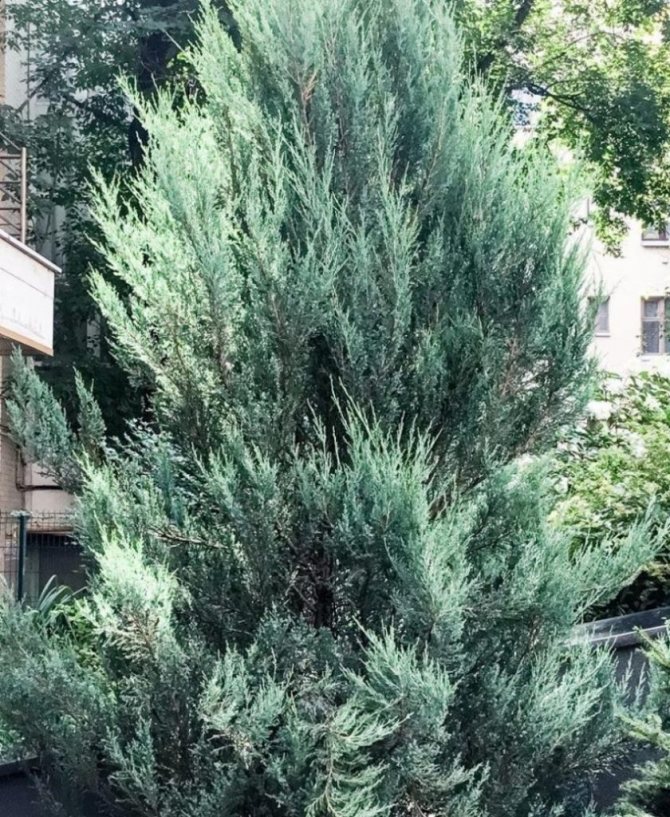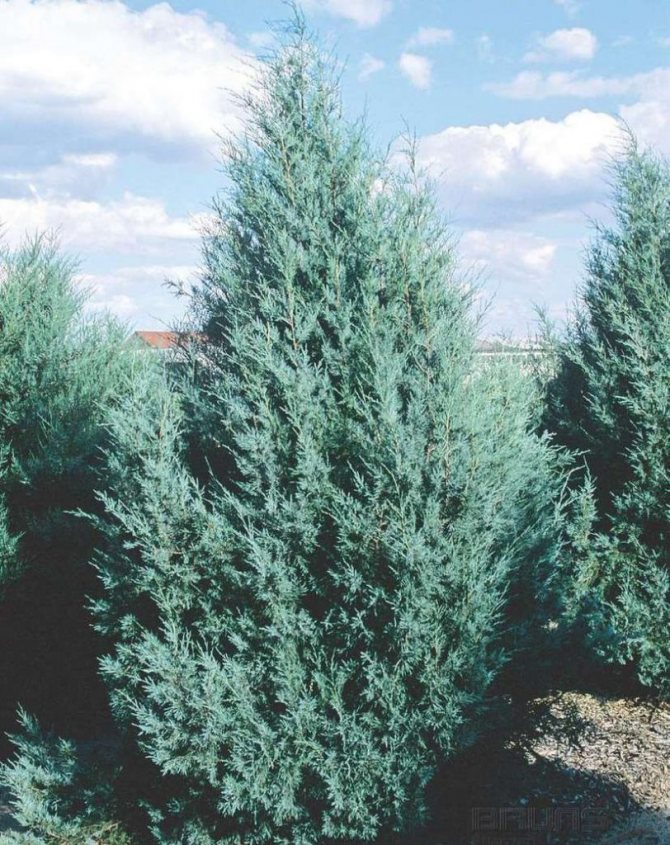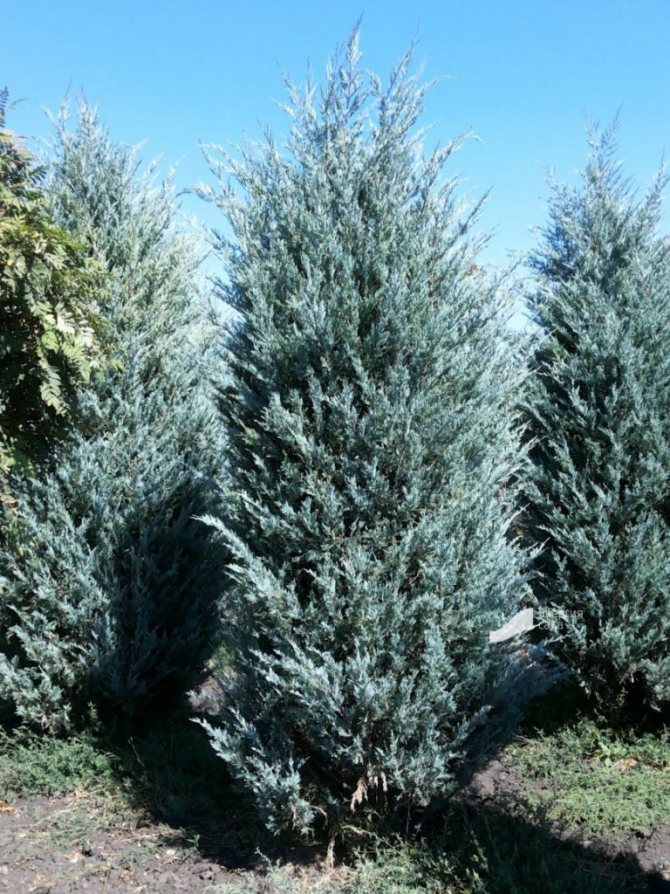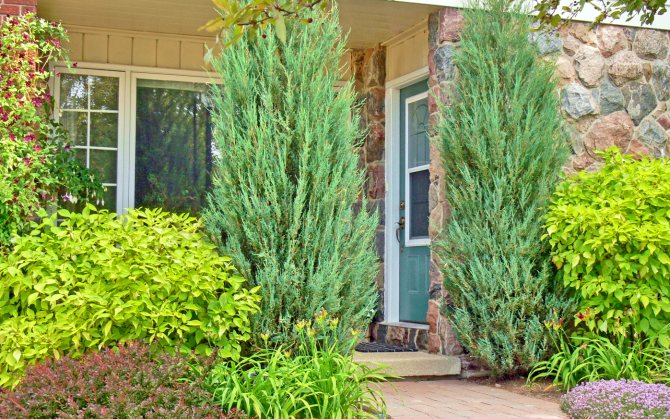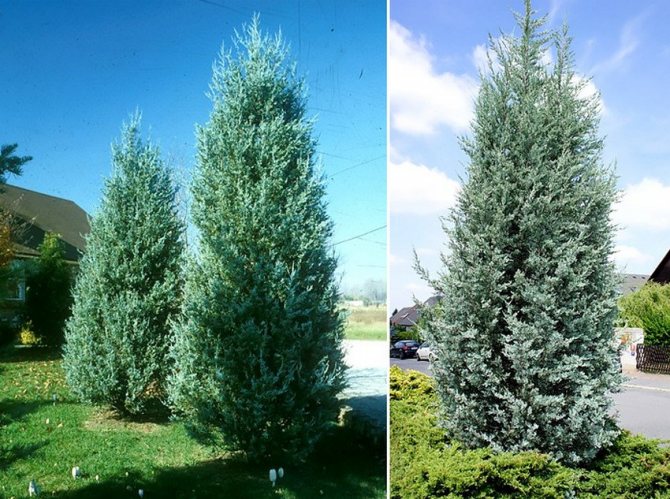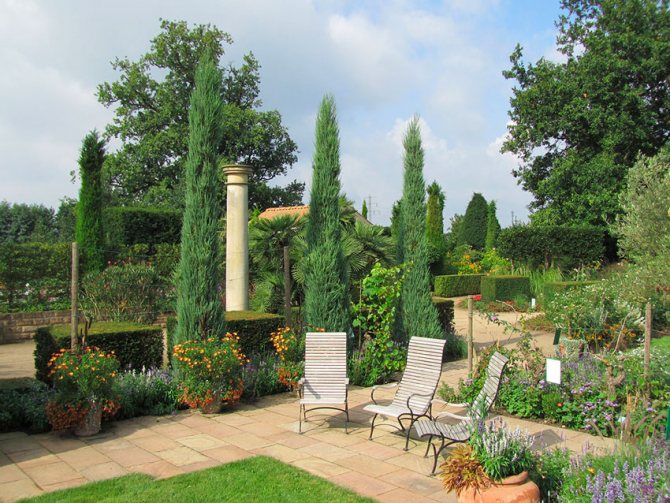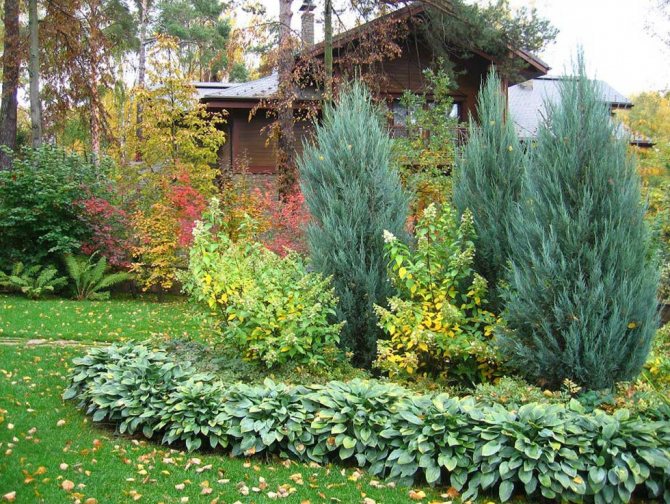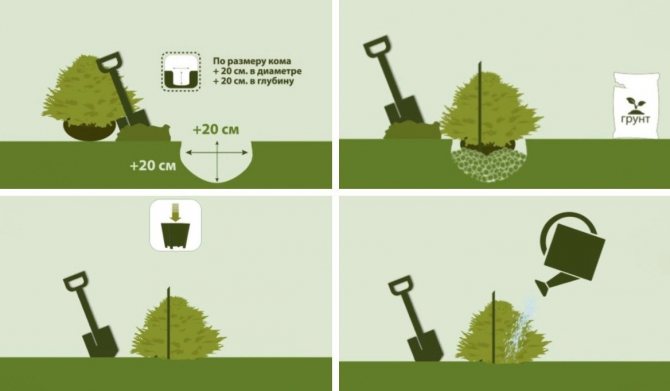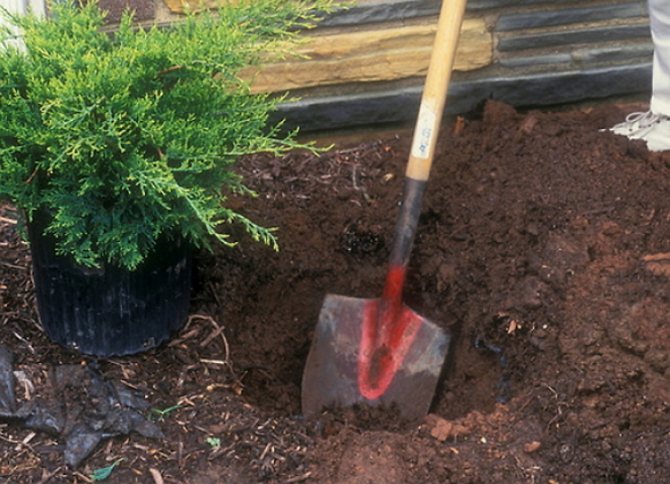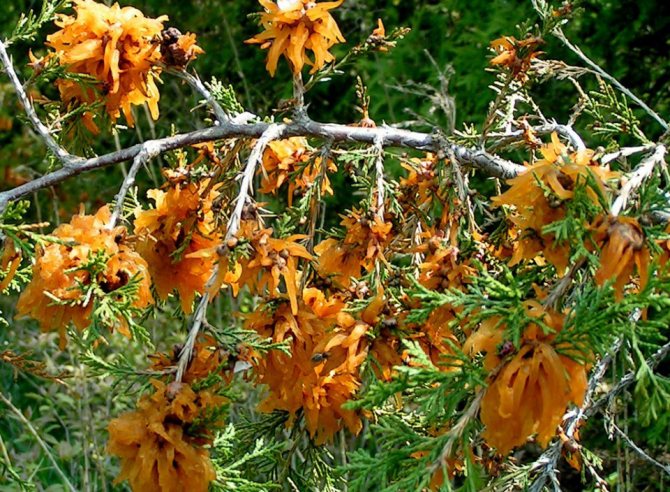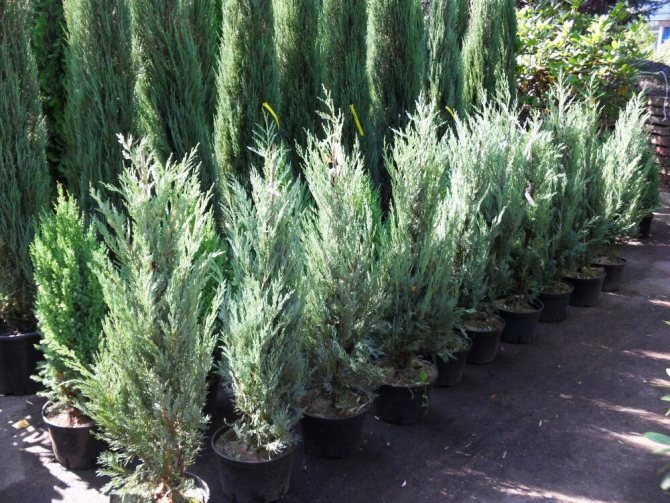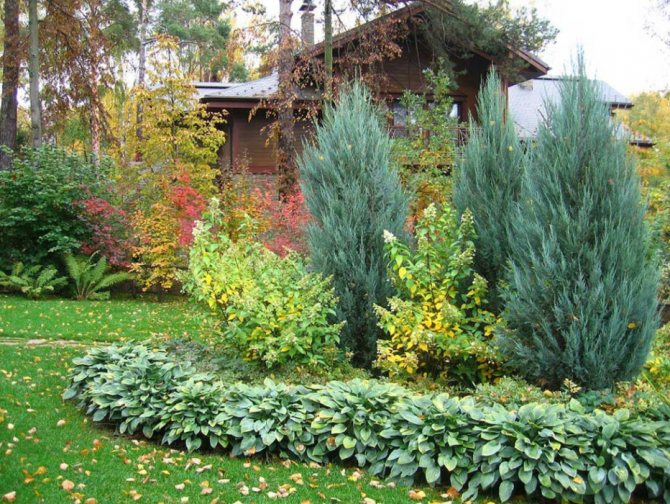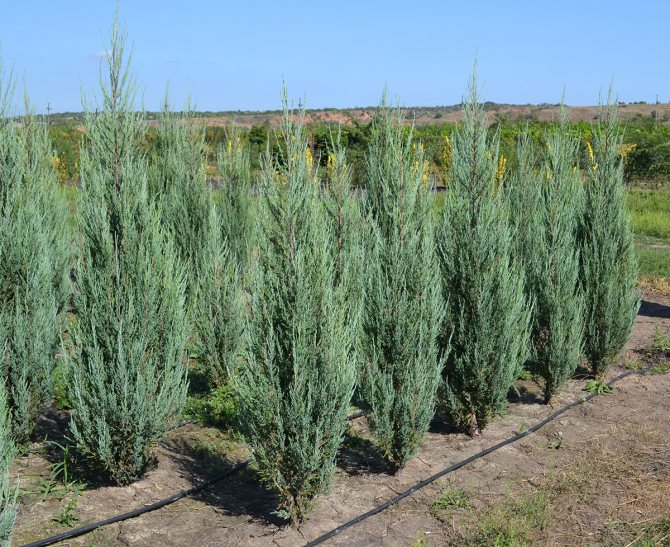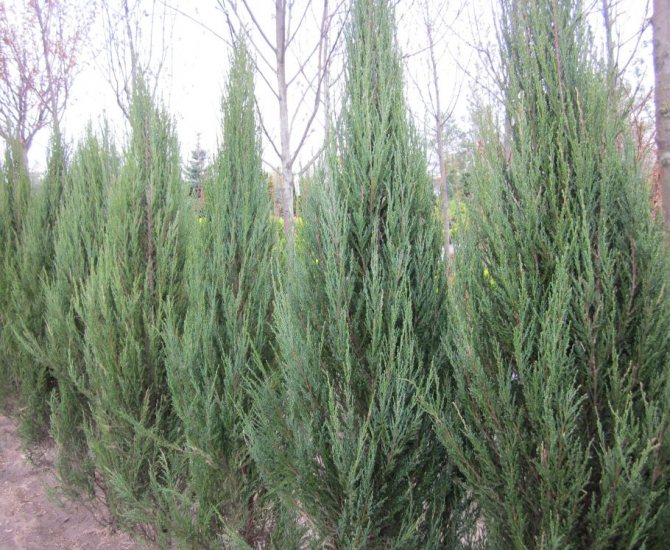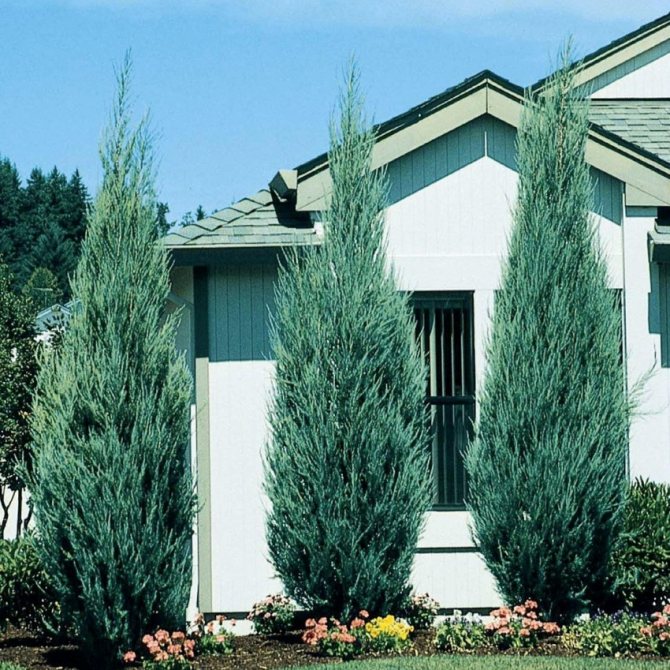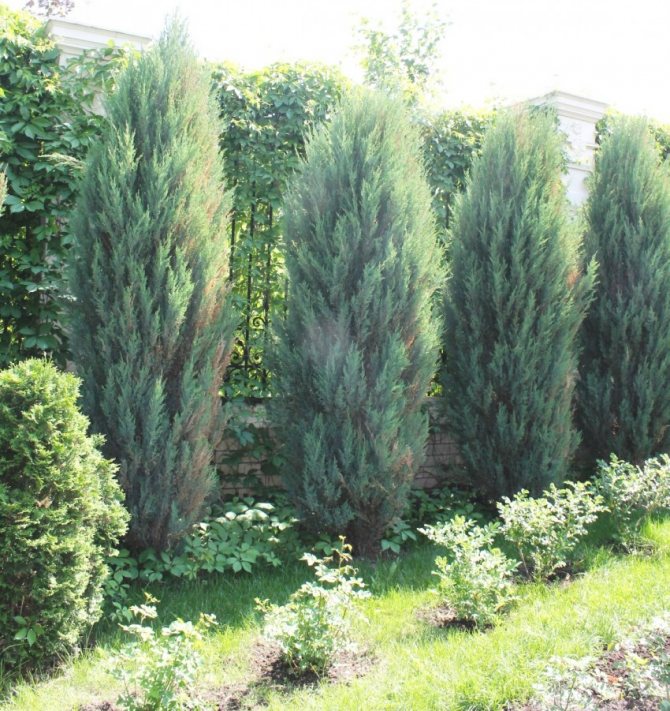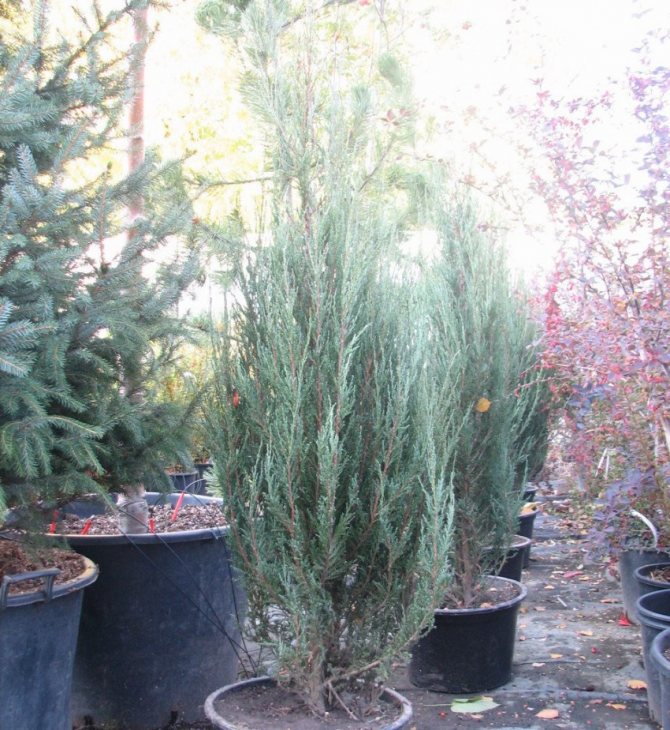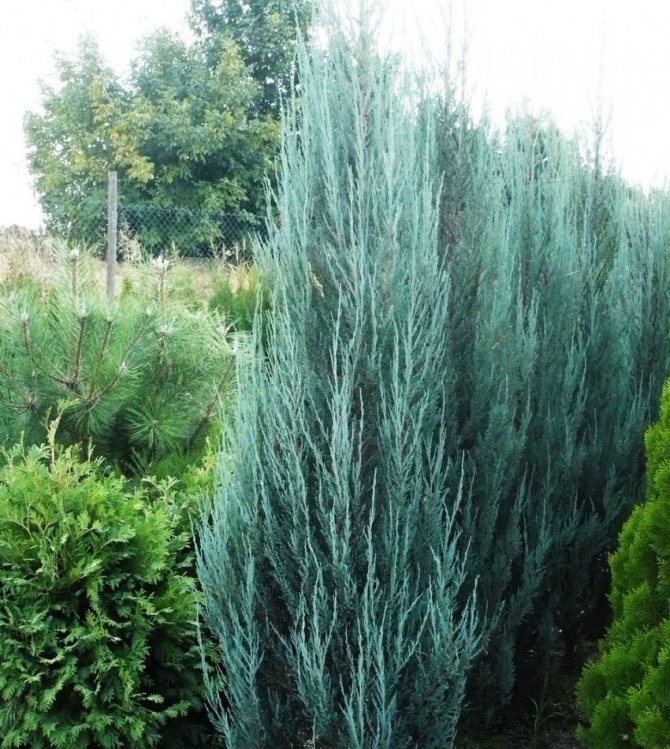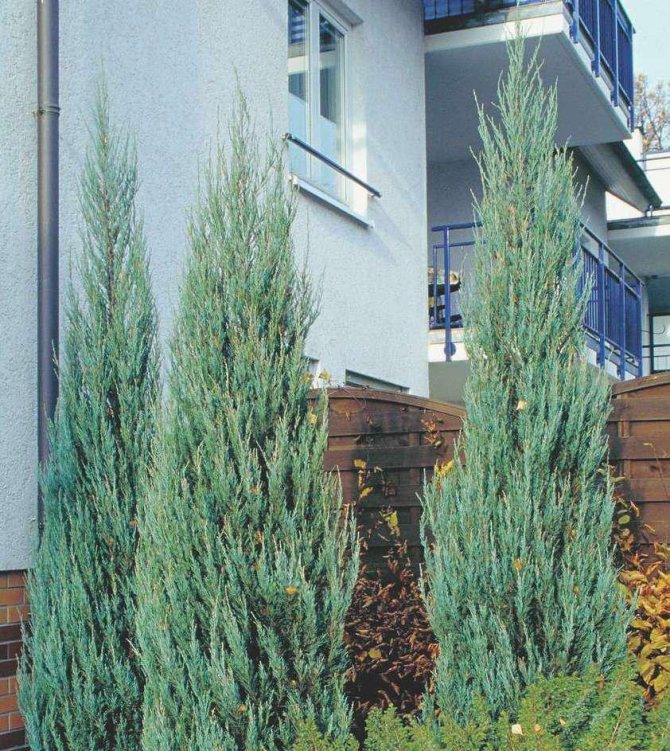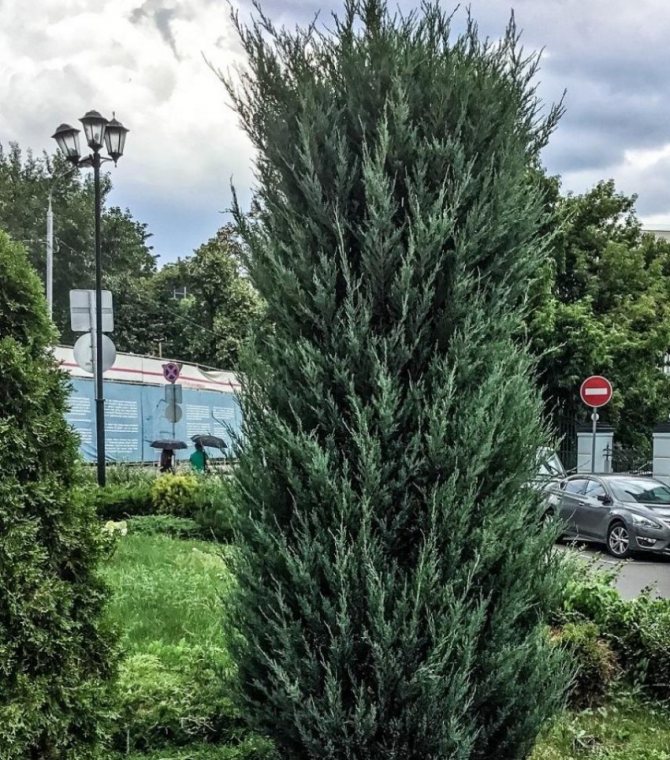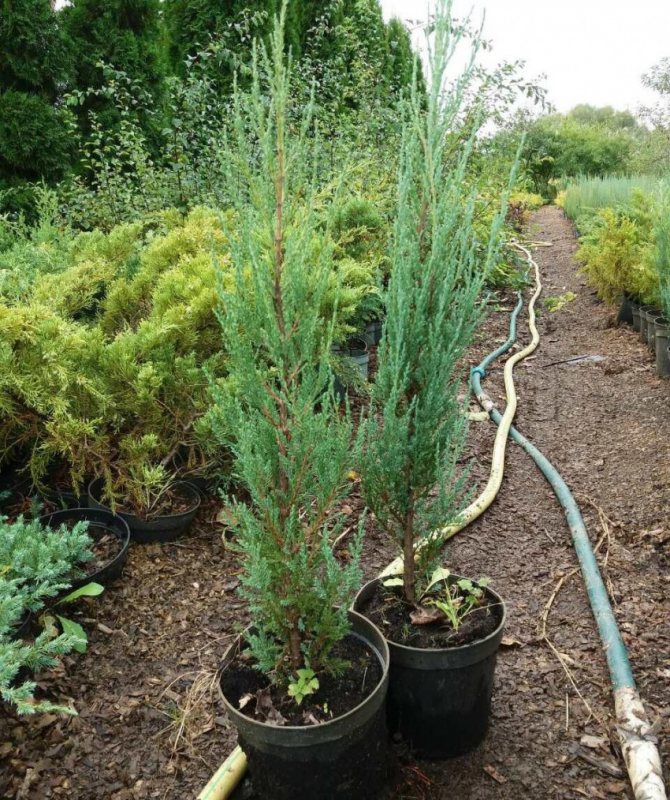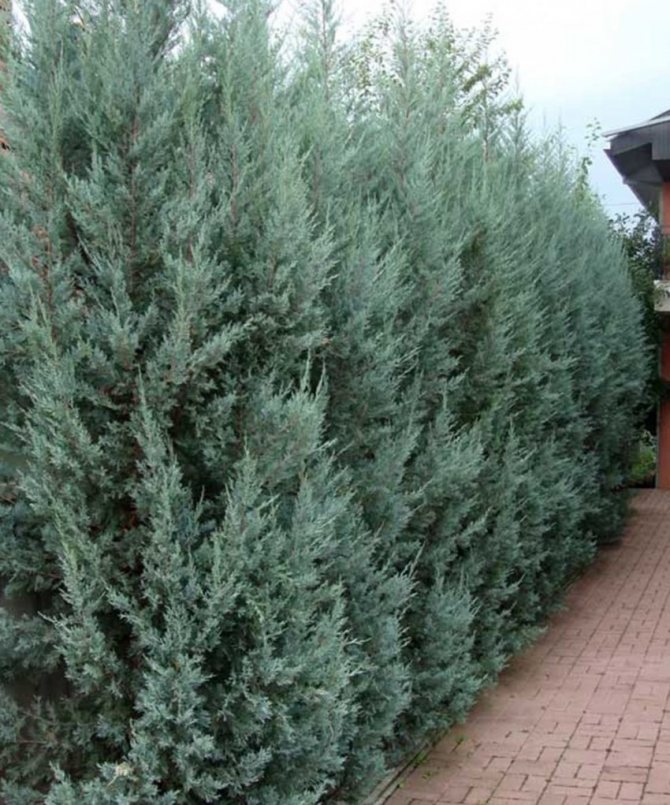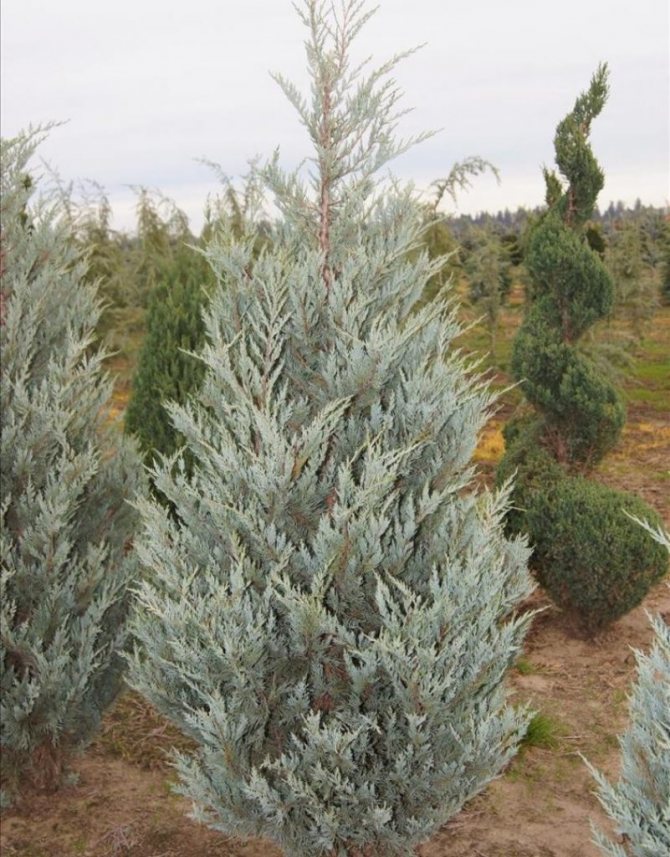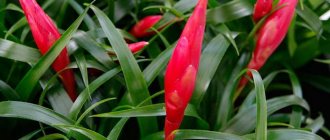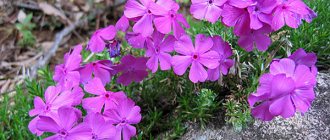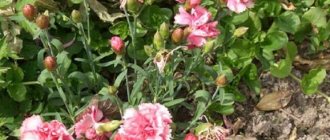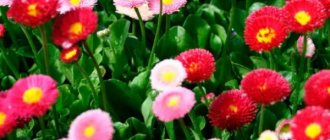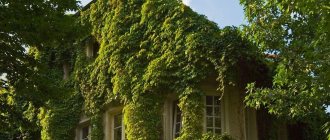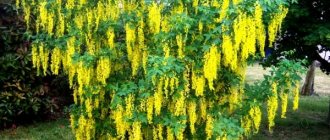The amazing blue color of the needles distinguishes the Blue Arrow juniper among other ornamental plants and makes it especially popular for growing as an original element of landscape design when arranging the local area.
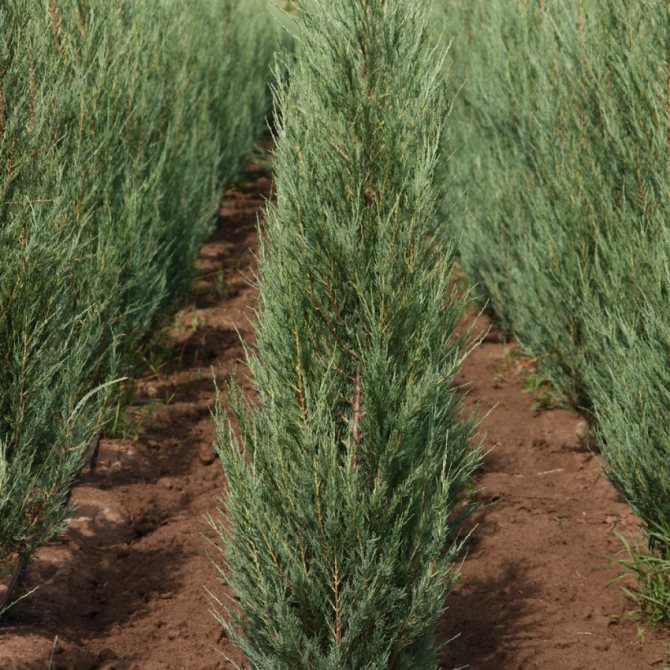
The rocky juniper, which has perfectly taken root in central Russia, is characterized by a complex of decorative qualities, its name - Blue Arrow, fully corresponds to the appearance of a tall and gracefully slender shrub with a cone-shaped crown.
General Description of Blue Arrow Juniper
A coniferous, evergreen bush, which, under good conditions, can reach a height of up to 5 m, already in the tenth year of life grows to a mark of 2.5 meters, is distinguished by vertically growing branches tightly pressed to the trunk.
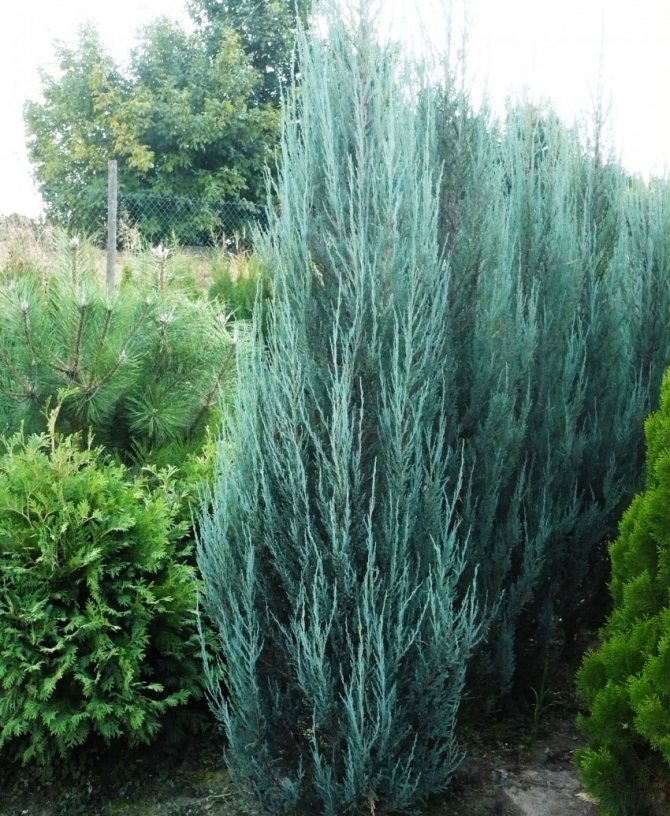

Each year, the branches growing by 10-15 cm are covered with a pleasant to the touch, scaly and soft needles, of an amazing shade, its color ranges from blue to deep blue, the bush bears fruit with cones, outwardly similar to berries, small in size and densely dotting the plant.
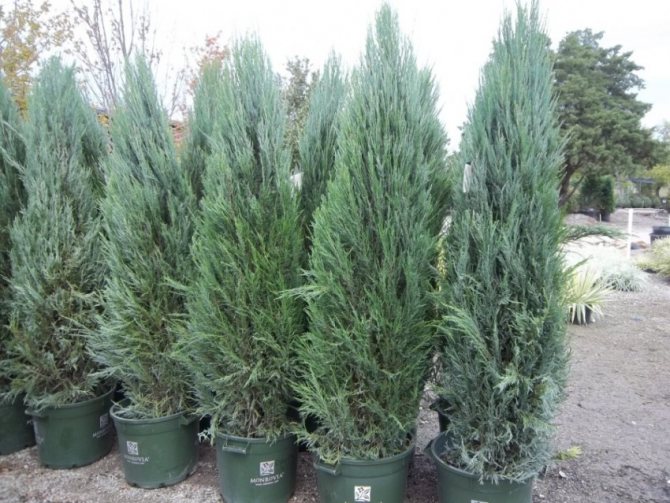

Botanical description
The natural habitat of rocky juniper is the mountains of North America. It grows high in the mountains. It was first described by botanists at the end of the 19th century. Later, the plant began to decorate personal plots. The unusual blue color of the needles and unpretentious care have earned the recognition of this variety as the most beautiful among junipers.
Did you know? If a branch of a juniper that has deviated to the side is alive, it is enough to pull it up with a rope. After a while, she will return to her place.
Blue Haven Rock Juniper is a perennial tree-like coniferous plant... The crown shape is columnar. The branches grow vertically, the shoots are dense and close to each other. An adult reaches 5 meters in height and 1.5 m in girth.
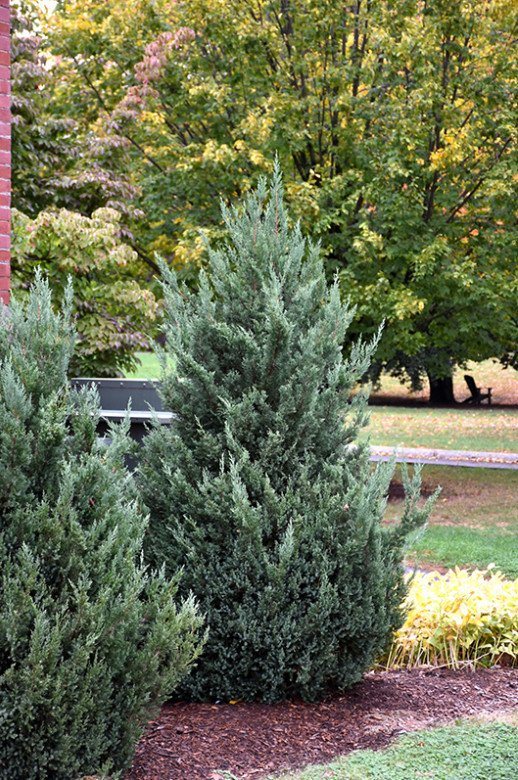

The variety grows quickly compared to other juniper varieties. On average, it grows 20 cm in height and 5 cm in width per year.
The color of the needles is sky blue, which does not change throughout the year, but silvery specimens can also be found... The needles are medium in size, in young plants in the form of needles, and in adults - scales.
The shape of the shoots is tetrahedral. Branches from the trunk branch off at an acute angle. Shoot formation begins almost from the ground, while the trunk is not exposed... The bark of young shoots is red-brown and smooth to the touch. In adults, it brightens over time.
The fruits of the juniper are dark blue cones with a bluish bloom.
Juniper propagates by grafting and grafting... When grafting, prepared cuttings are planted in a greenhouse. After six months, they take root. Then they are transplanted to the garden bed, where they grow for 3–6 years.
Important! Planting takes place only in April. Due to the impressive size of the plant, an interval of 2-3 m is made between the seedlings.
The variety is light-requiring, although it grows in partial shade.... He is not too picky about the soil, but he prefers more not too fertile. Grows on saline soils. It perfectly tolerates frosty winters, has good wind resistance. It can grow in conditions of urban and industrial pollution.
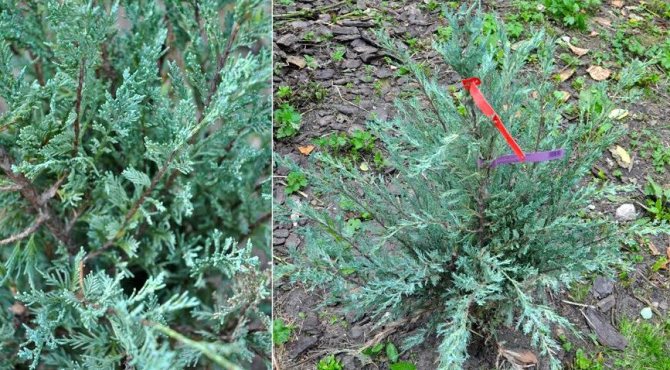

Main Features of Blue Arrow Juniper
The plant belongs to the Cypress family and its natural habitat is limited to some areas of Canada, the USA and northern Mexico, most often it can be found on rocky soils and mountain slopes.
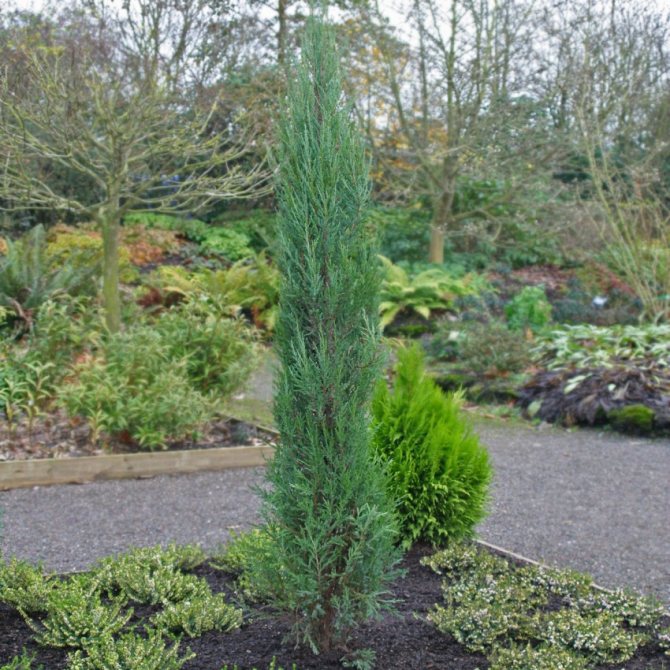

The crown of a shrub is formed at the very base of a narrow trunk covered with brown bark, young shoots are distinguished by a light color, which gives the plant an extraordinary look, which allows it to be cultivated for further use in transforming summer cottages and backyards, and the local area.
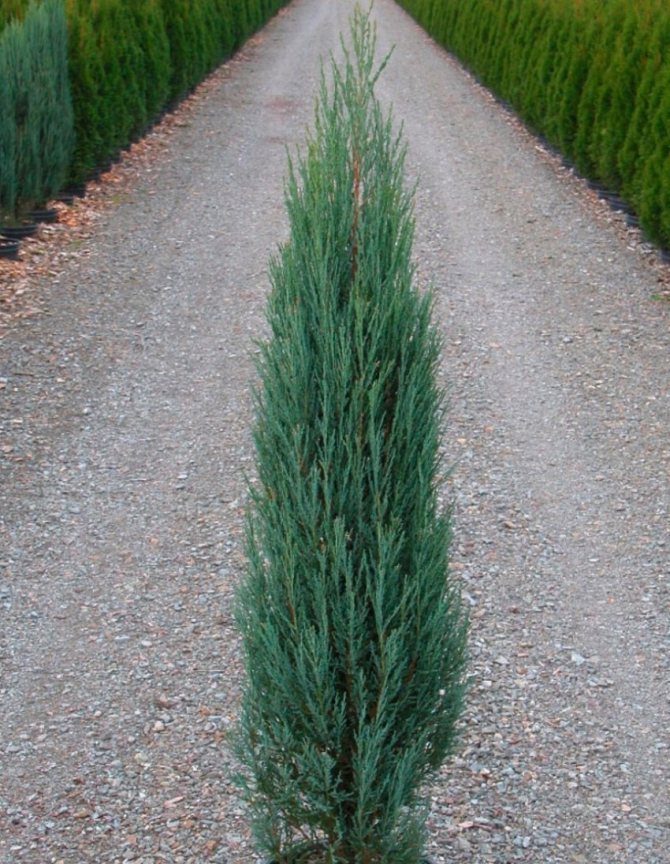

Basic principles of care
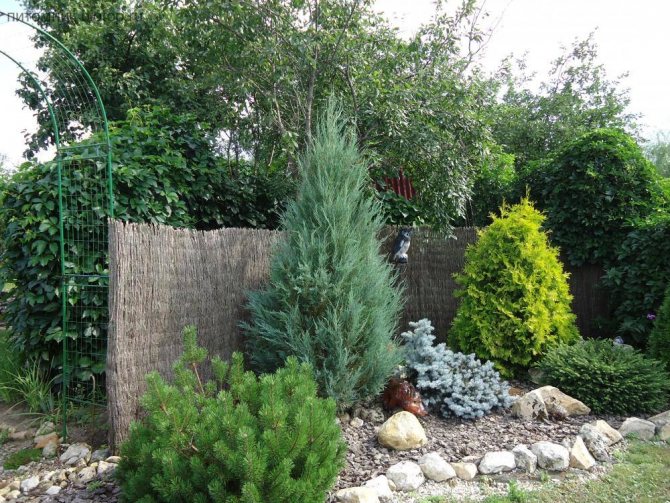

Caring for this ephedra is pretty simple. You just need to remember that the tree begins to grow actively after the 10th anniversary. Most of the varieties are perfectly adapted to both harsh winters and hot summers. They grow well even without human help.
Watering
Adult plants only need to be watered three times per season. Sometimes it is worth doing additional watering during a prolonged drought. It is better to spray young trees with warm water in the evening. Excess moisture is harmful to this drought tolerant plant.
Top dressing
Young trees are fertilized only once in spring, usually in April-May. It is recommended to use drugs such as Kemira-universal or Nitroammofoski. Adult specimens do not need feeding at all.
Pruning
Junipers do not need pruning, but sometimes this procedure is carried out to give the crown an unusual shape. However, even if a haircut is not planned, dried branches should be cut off. It is best to do this in March, before the sap flow begins.
Wintering
As already mentioned, almost all varieties easily tolerate the cold season, but you still have to prepare them for wintering. So that the snowfalls do not damage, the spreading branches must be pressed against the trunk, tightly wrapping the plant with a rope. Trees that were planted shortly before the onset of cold weather are recommended to be covered with spruce branches or non-woven material.
Transfer
The older the juniper, the harder it is when "moving" to a new place. To minimize the dangers, you need to keep an earthen ball, in which all the roots are hidden. Therefore, the ideal time for transplanting will be the period when the plant renews and enlarges the root system, that is, in mid-spring. Thus, the migrant adapts more easily and recovers his strength faster.
It is possible to transplant both in the middle of summer and in autumn during leaf fall, but this step will seriously slow down the development of the seedling.
In order for the transfer to be successful, it is worth adhering to a certain plan. A pit is dug in advance, capable of containing the entire earthen lump. The bottom is covered with drainage. A mixture is being prepared with which the foundation pit will be filled. The composition of the mixture is the same as that used for planting. Then the tree is dug in at a distance of 0.5 m from the trunk. After the bush is removed, it is transferred to the planting site on a strong film. The disembarkation process is no different from the primary one.
The use of a plant in landscape design
High, but the most compact juniper rocky Blue Arrow does not take up much space when landing on the site, therefore it is suitable for decorating confined spaces and small areas, creating plant compositions.
When forming garden and walking paths, the plant looks impressively like a living fence, it is planted alone on lawns or combined with other shrubs and deciduous and coniferous trees, the plant can often be found in front of municipal and public buildings.
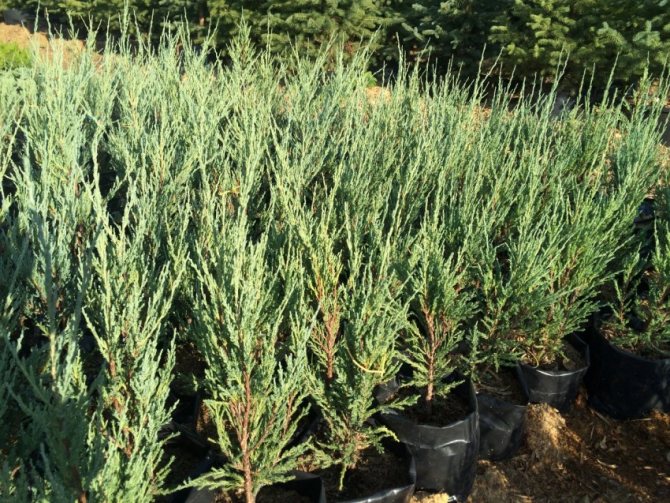

Juniper pruning
Since the crown of the rocky juniper initially has a certain shape, it does not need formative pruning. He only needs a sanitary cleaning. How to prune rocky juniper? In early spring, before the start of sap flow, on a cloudy day, the plant is freed from broken, dry, diseased and improperly growing branches and shoots. Since the annual growth of adult plants of this species is only 10 cm, shearing of rocky juniper in order to align the contours of the crown, it is carried out no more than 2 cm.
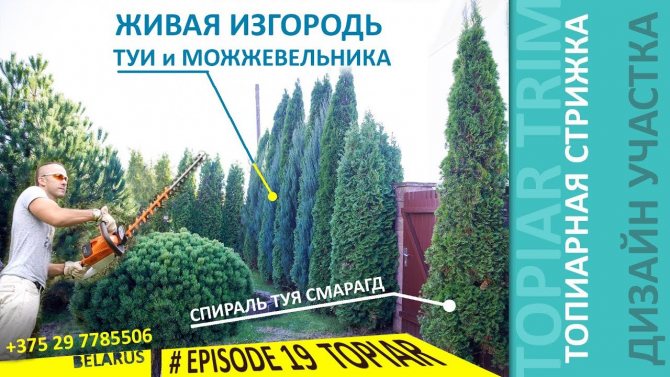

Plant propagation: planting and transplanting
Dominating on any site due to its bright color, the shrub acts as an amazing accent in any landscape design composition; for its use and reproduction, it is necessary to organize proper care.
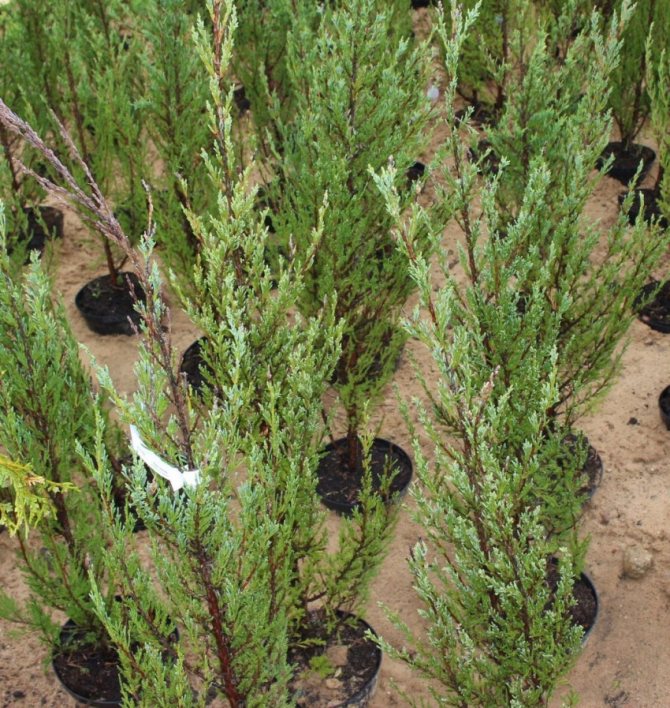

Rock juniper is quite unpretentious, but for normal growth it is important to water the plant on time and protect it from pests that can cause irreparable harm to the crown and root system, which will lead to a slowdown in its growth and even to the death of the shrub.
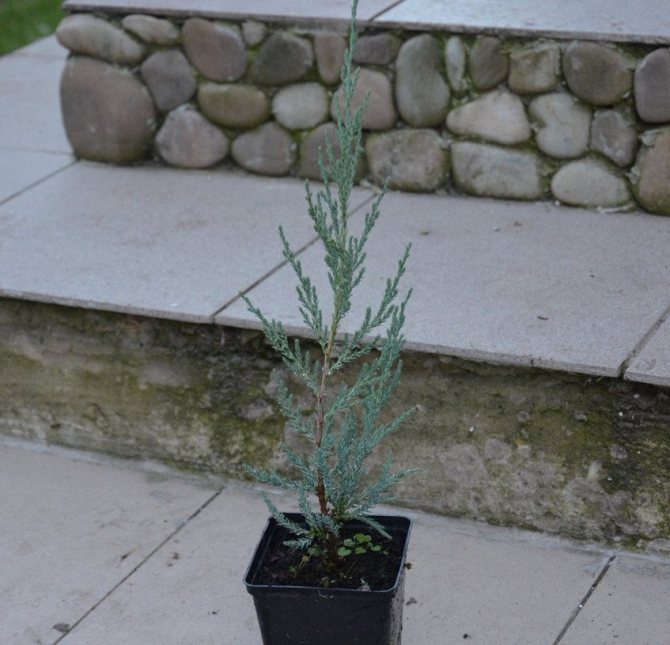

Landscape
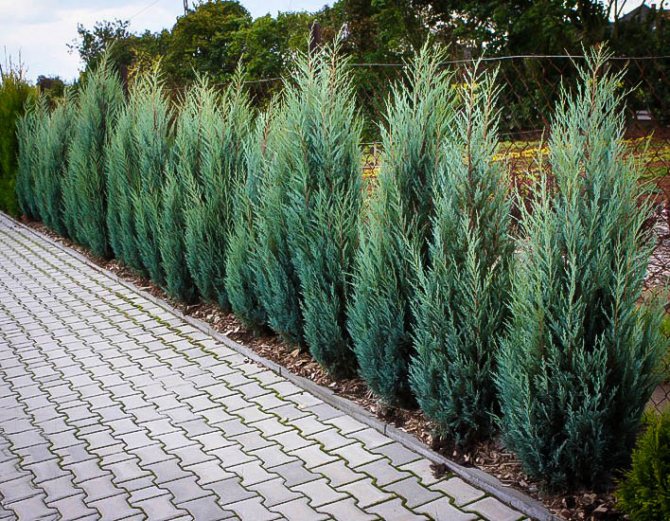

Munglow Juniper
A poorly spread culture gradually gained popularity. Today, rocky juniper is actively used to create design compositions on private estates and public areas. Such bushes help to create recreation areas as close as possible to natural conditions. Different varieties look great without additional elements of landscape design and can be combined with other plants.
The most popular Munglaw juniper in landscape design, due to its compact size and interesting color. The plant looks especially impressive in winter, when its color against a snowy background becomes even brighter. The popularity of the rock in the landscape is due not only to its ease of care and maintenance, but also to its unusual geometric shapes. Often, juniper becomes a beneficial backdrop for other plantings, complementing various design compositions. The culture is great when creating a Japanese-inspired garden landscape and for decorating large alpine slides.
The crown of the rocky juniper is quite effective due to the fact that it is geometrically correct and clear. It is often used as a background for other plants or as a central link in a garden composition. This plant is perfect for those plots that are decorated in English or Scandinavian style, and the juniper will also look great in alpine or Japanese gardens.
Watering
At all stages of development and vegetation, the Blue Arrow needs regular watering, this is due to the compactness of the root system, which is incapable of growing and poorly absorbing moisture and nutrients useful for the bush from the soil.
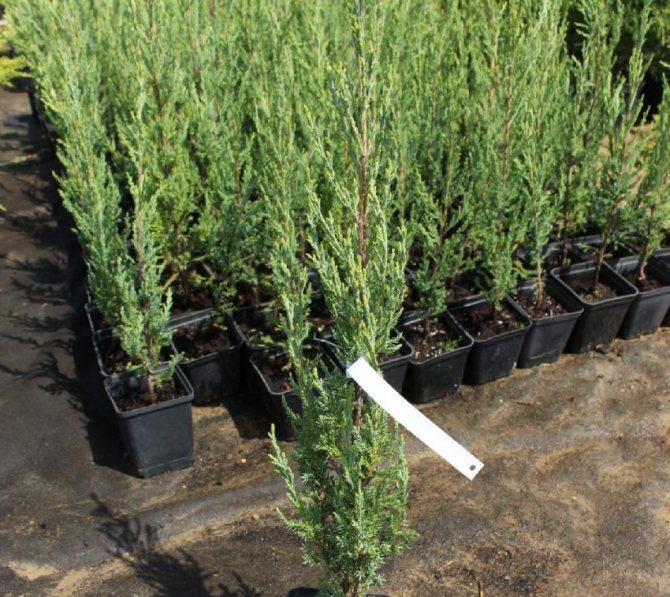

In the dry and hot season, the plant is watered at least 2-3 times a week, to maintain the optimal level of soil moisture, mulching is carried out, which reduces the amount of watering, after natural rains, it is recommended to loosen the soil around the plant by hand.
Reproduction methods
There are three suitable ways:
- vaccination;
- seeds;
- cuttings.
The first method is more laborious and is more often used by breeders to develop new valuable varieties and hybrid forms of ephedra.
The second option takes a lot of patience and time. In addition, seedlings do not always live up to the moment of transplantation to the site - most of them die from a lack of light, moisture, damage by diseases and pests at home. Seedlings after they grow back need repeated picking, as a result of which only a few specimens survive. Amateur gardeners prefer to propagate pine needles by cuttings.
Harvesting and planting
The branches are cut in the spring during a sanitary cut, and you can also prepare them in the summer. Cut off the top cuttings 15-20 cm long with a piece of lignified bark.
The cut segments are freed from needles and growths in the lower part, sprayed with one of the growth stimulants - Epin, Kornevin or Heteroauxin.
Then they are planted in a moist and nutritious substrate at an angle of 40-45 ° C to a depth of 3-4 cm. Irrigate with warm water, cover with a film and put in a warm place with bright diffused light.
Care
Rooting can take a long time - from 2-3 months. In order for the seedlings to take root and not dry out, they should be ventilated every day, moistened, weeds should be removed as they grow, and the soil around them should be gently loosened.
Optimal conditions of detention are 20-23 ° С, humidity is within 70-75%.
As soon as young buds appear on the branches, you can remove the shelter, transfer the planting to a cool room with a temperature of 17-19 ° C.
Growing at home is carried out 1.5 years from the moment of rooting, then transplanted into open ground. The best time for transplanting is early or mid-September, so that the needles have time to adapt and take root in a new place.
Landing
Experienced experts recommend planting seedlings from transport containers directly with a clod of earth that hides the root system; it is placed in a pre-dug hole that is 2 times larger than the clod of soil, which will ensure good rooting.
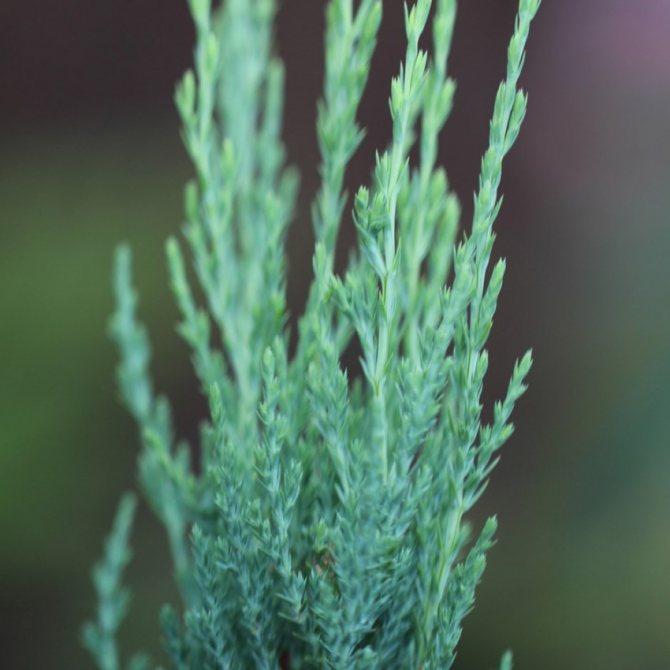

Acidic soil, diluted with lime, for better and high-quality rooting, mineral fertilizing is introduced into the soil, and when planting, the root collar is not covered with earth, it should be at the same level with the soil, materials such as pine chips or crushed tree bark are used for mulching.
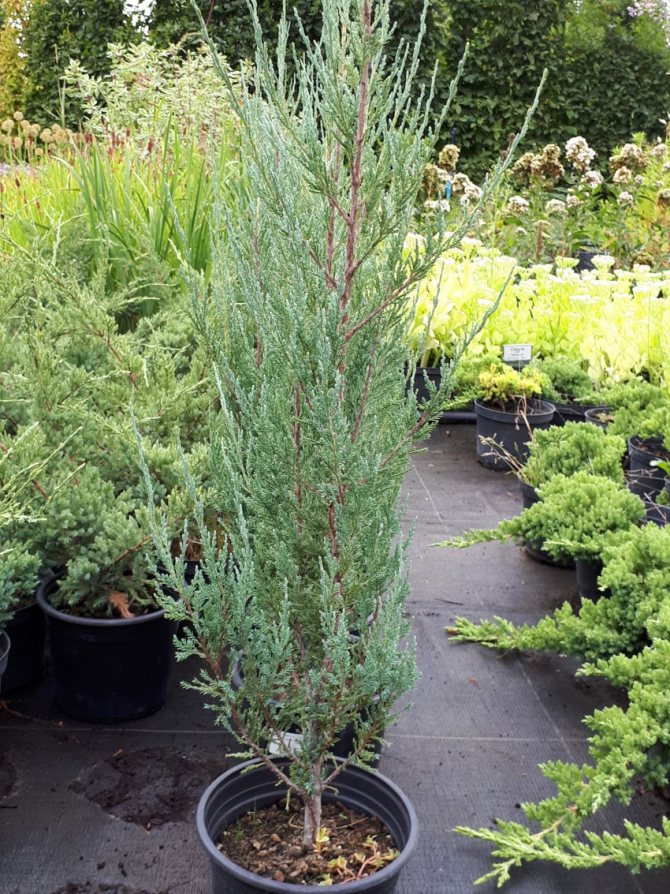

The best varieties
Juniper horizontal: description, best varieties, planting and care
As a result of selection, the world knows more than one variety of culture, they are gradually gaining the confidence of gardeners. American breeders have developed the following popular varieties today, which are planted in mid-latitudes:
- Rocky juniper Blue Air. The height of the plant can vary from 150 to 250 cm. A feature is considered to be a narrow, columnar crown, no more than 50 centimeters wide. Needles are needle-shaped, green-blue in color, scaly with a metallic sheen;
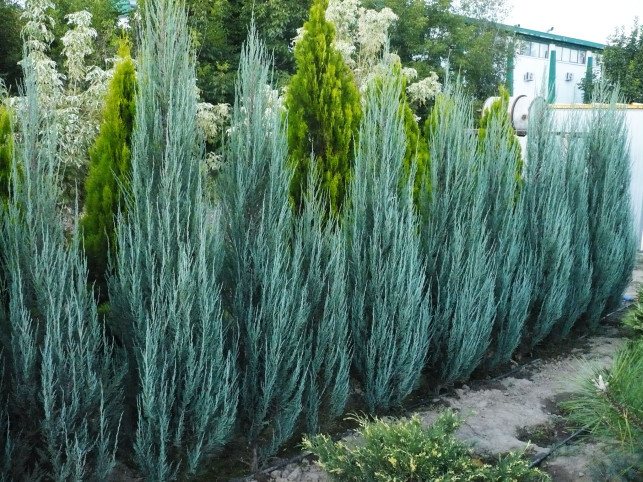

Rocky juniper Blue Air
- Blue Haven - low bushes, 0.2 meters high. They have a pyramidal crown, the width of which is 0.1 m. The color of the plant is light blue all year round;
- The Blue Sky juniper is one of the few winter-hardy species, reaching 6 meters in height at 10 years of age. It features a narrow and slender trunk and straight, adjacent stems. The needles, like other species, are scaly, green-gray in color. Most susceptible to attack by fungal infections;
- Moffat Blue. The difference between the variety is winter hardiness. Dense wide crown of a pyramidal shape. The needles are greenish blue. The maximum height is 6 meters, with a crown width of 130 cm. Does not like excess moisture, which makes it impossible to grow the variety in regions with high humidity;
- Munglow is similar to Blue Haven in many ways. The only difference is the blue-silver color of the needles, which becomes even brighter in winter;
- Silver King. A bush with wide spreading branches. At 10 years of age, it reaches 60 cm in height, with a crown width of up to 2 meters. Like everyone else, the needles are scaly, blue in color;
- Table Top Blue - has a characteristic oval crown, with a blue-silver color. After ten years from the date of planting, the plant has compact dimensions: 2 m in height with a crown span of up to 2.5 meters;
- Wichita Blue. It has open branches, the maximum width of which is 150 cm, with a height of a 10-year-old tree of 40 cm. Color - silver-blue.
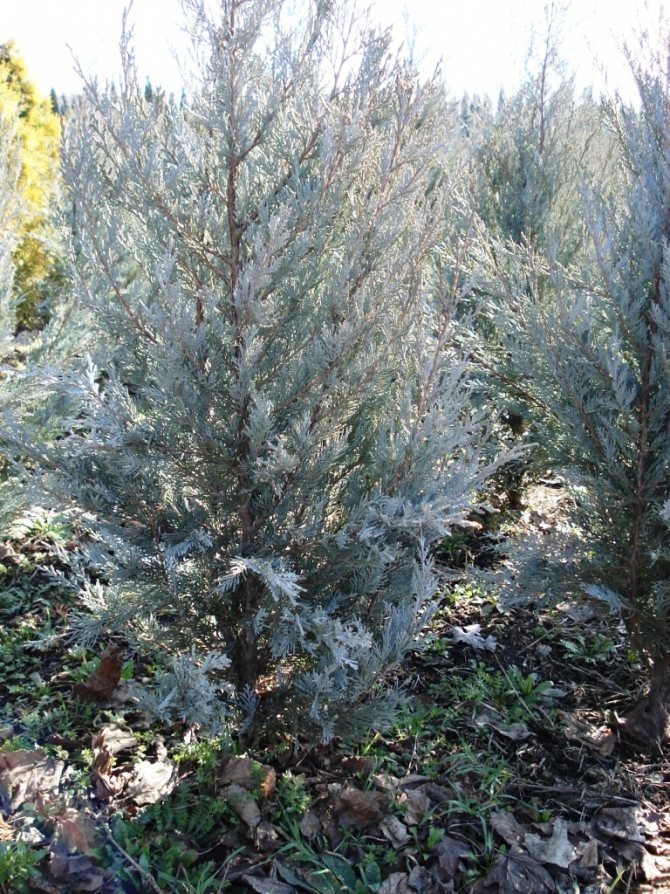

Wichita Blue
In addition to the species described above, others are also used in gardening: the juniper Fisht, Green, Erekta, Medora, Gray Glim, etc.
Pests and diseases
The most common disease of Blue Arrow juniper, which is described in this article, is rust, it affects young and old branches, which spoils the appearance of the entire plant and threatens its further growth.
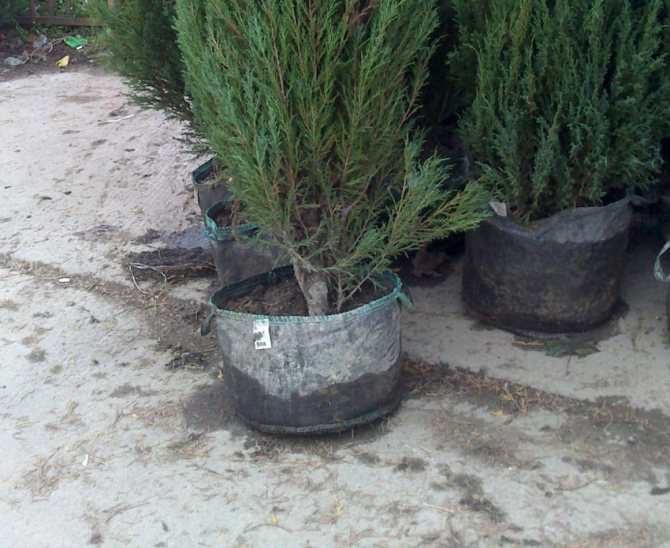

In addition, the plant is attacked by such parasites as aphids and miner moths, spider mites and scale insects, regular treatments and spraying will help prevent infection of the shrub with diseases and pests, disease prevention is the best way to strengthen the immunity of the bush.
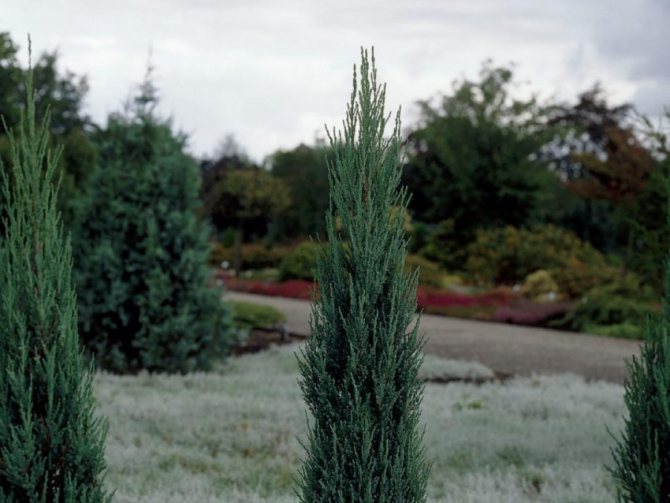

The peculiarities of caring for a rocky juniper consist in the mandatory carrying out of sanitary pruning, which is important not so much for the formation of the crown, as for improving health and enhancing the growth of young shoots that have successfully wintered.
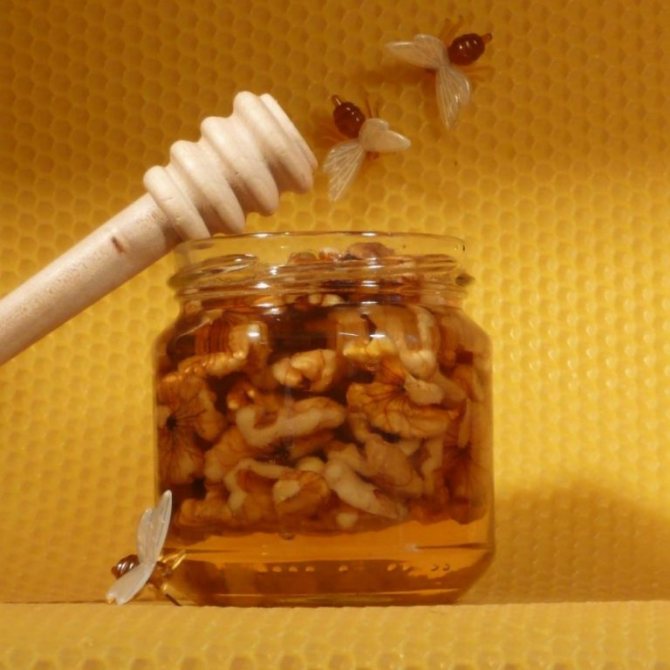

Nuts with honey: benefits, harms, recipes and use in traditional medicine (110 photos + video)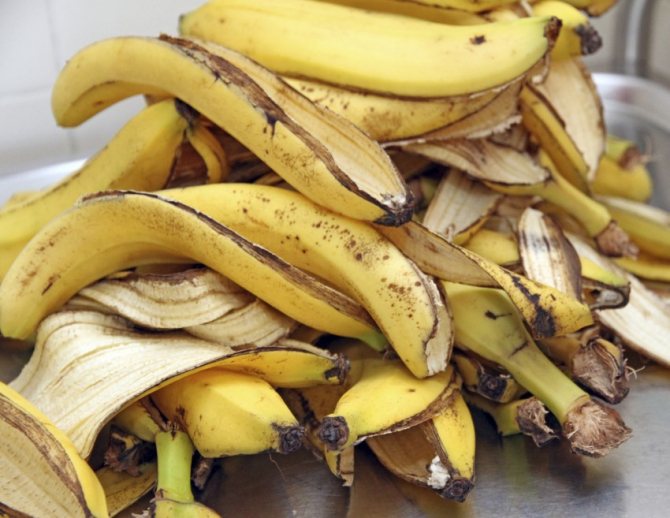

Banana peel as fertilizer - instructions on how to properly prepare high-quality fertilizer for seedlings with your own hands (125 photos + video)
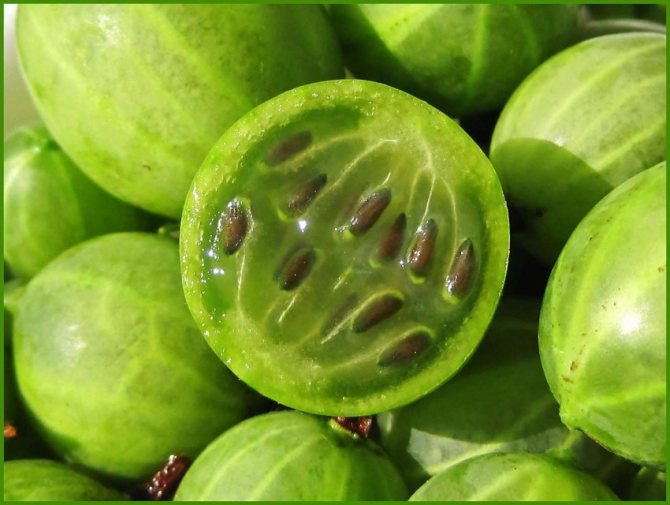

How to feed gooseberries - the best recipes and feeding methods in spring and autumn. Features of gooseberry care in August (85 photos)
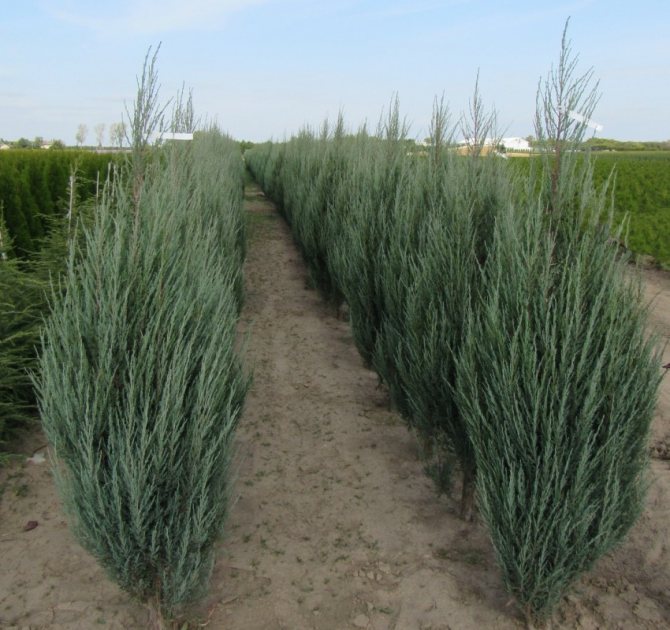

Coniferous plant care
Gardeners like rocky juniper due to its unpretentiousness. A tree or bush grows well on its own, without difficult maintenance.
Watering, feeding and pruning
The culture has enough moisture and minerals, which can be extracted from the soil with the help of strong roots. Watering is desirable only in the first year of planting and during a long drought. An adult crop, even in a drought, is watered no more than 3 times per season. In the evenings, it is permissible to spray the crown with warm water. Top dressing is not required. It is allowed to apply nitrogen and complex fertilizers in small doses 2 times a season.
A haircut should be done in order to give the crown the desired shape. Thanks to her, the juniper gradually turns into an original element of the landscape. Dry branches are cut in any case.
In the near-trunk circle, the earth is loosened from time to time, mainly after watering or heavy rainfall. Weeds are removed.
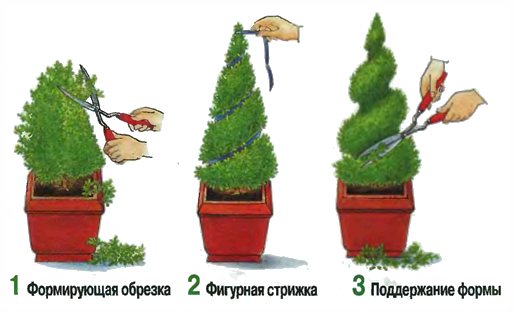

Coniferous pruning options
Reproduction and transplantation methods
They are engaged in transplanting in the spring, until the buds have blossomed on the plant. During this period, the maximum root formation takes place. In summer, it is better not to do this, since the needles evaporate a lot of moisture, leading to the weakening of the plant. As a result, adaptation to a new location will take longer.
If you are replanting an adult plant to a new location, try to keep the old earthen lump on the roots. This will help the culture take root more quickly.
Author's advice
2 methods are suitable for reproduction:
- Cuttings or young layering. The upper, partially lignified shoots are chosen. They are cut off, capturing older sections of wood. The method is suitable for creeping species. Apply it during the growing season. The stripped shoots are rooted in the soil, securing with hairpins. Rooting will be completed in 0.5–1 years.
- Vaccination (for especially valuable breeds). The method is complicated, therefore it can only be used by experienced specialists.
Wintering features
Although most varieties of the crop are resistant to cold weather, it is recommended to cover the plant for the winter with spruce branches and other similar material for the first couple of years. Later, having got stronger, he will not be afraid of frosts. The abundance of snow harms the branches of dwarf varieties. Experienced gardeners advise tying the plant in the fall, pressing the shoots to the trunk.
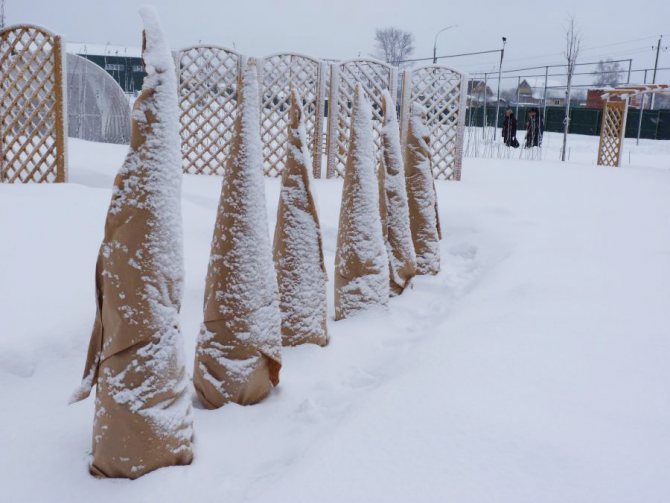

Young juniper is insulated for the winter
Diseases and pests
There are a number of cultural ailments. If they are identified in time, treatment quickly helps to return to normal:
- Rust - reddish growths appear on the shoots, filled with an oily substance. As a result, the culture begins to dry out and dies. Treatment involves the removal of damaged branches (they need to be burned), then treatment of the plant with fungicides: "Bayleton", "Skor" and analogues.
- Fusarium wilting occurs when there is an excess of moisture. The affected branches are cut off, then the entire trunk, branches and the ground under it are sprayed with fungicides: "Quadris", "Fitosporin-M".
- Drying of branches - the needles turn yellow, the bark is covered with fungi. For treatment, diseased branches are cut off, sprayed with "Tilt", "Ridomil Gold MC" or "Skor".
- Brown shute - the needles turn yellow and fall off. The reason is too much moisture or lack of sunlight. For treatment, sanitary pruning, spraying with "Quadris", "Skor" or "Strobi" is used. The affected branches are removed.
Of insect pests for a plant are dangerous:
- miner mole - “Decis” solution is used for treatment;
- scale - is eliminated by "Karbofos" and similar acaricides;
- aphid - treatment with Fitoverm helps;
- spider mite - the same medicines are relevant as against the scabbard.
Home content
The plant is so beautiful and decorative that many housewives prefer to keep it in the house. This is the right decision, because it becomes possible to neutralize the air and fill it with pleasant essential oils, which will have a beneficial effect on the health of every family member.
Juniper is unpretentious, so it gets along well in pots. The most important thing is optimal conditions:
- a sufficient amount of daylight;
- lack of direct sunlight;
- temperature not exceeding 20 ° C.
It is advisable to spray the plant. This is beneficial for the juniper itself and helps to get an extra dose of a pleasant, healthy scent. In the summertime, it is better to take the pot out to the terrace or balcony.
But in order to grow a juniper at home, you need to be more careful about the choice of soil. It can be a mixture of peat and sand. It is advisable to loosen the soil periodically. The plant has a well-developed root system; a spacious pot is required.
Juniper is a beautiful, unusual columnar-shaped plant that will become a real decoration for a home, plot, country residence, city park, office area. It is undemanding to care for, does not need a haircut and creates an unusually favorable atmosphere in summer and winter.
Some gardeners decide to decorate their winter garden, central office hall, reception room or greenhouse with a magnificent coniferous plant. Juniper grows readily at home. The main thing is to provide him with optimal conditions. The plant likes light, but it does not tolerate direct sunlight. The ideal option would be to place it in front of the southern window in winter, and in front of the northern window in summer.
It is very important not to overheat the air. The recommended air temperature is 20, its decrease is unacceptable more than up to 13 degrees. In the summertime, it is best to take the pot out to the balcony or garden. Surprisingly, the juniper, which does not tolerate drafts at all, grows very well in the fresh air. Over the summer in the garden, it can grow strongly.
Differences from Skyrocket juniper
Junipers Skyrocket (Sky Rocket) and Blue Arrow are very similar to each other. Inexperienced gardeners can easily confuse them. But if you look closely, you can see that the first grade has a more lush crown, and the dimensions of an adult tree are much larger. Landscape designers in recent years often prefer Blue Arrow, because it looks impressive, while being compact and does not require much space.
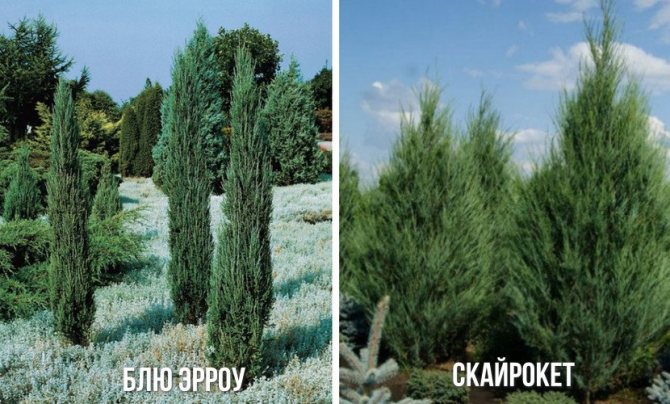

How to propagate?
Rocky juniper can be propagated in two ways:
- vaccination;
- by cuttings.
The first method is more often used for valuable breeds and is usually carried out by a professional.
In the second method, cuttings prepared in early March are planted in a greenhouse. Semi-lignified shoots from the upper part of the bush are cut off together with the woody heel. Rooting time from 1.5 to 6 months.After that, the baby is moved to a training bed, where he spends from 3 to 6 years.
Useful qualities of the plant
The scop blue arrow juniper has excellent antiseptic properties. It releases biologically active substances - phytoncides, which destroy pathogens. The plant bears fruit - blue cones that can be eaten. Berries are very healthy. They contain essential oils, vitamins and a variety of trace elements:
- zinc;
- manganese;
- calcium;
- potassium;
- copper;
- magnesium and many others.
Juniper berries are a powerful antiseptic used to disinfect and heal wounds. They also have an antispasmodic and antifungal effect, improve digestion, give a diuretic effect, and relieve joint pain. On the basis of juniper, preparations have been created for the treatment of many diseases:
- rheumatism;
- arthritis;
- diseases of the upper respiratory tract;
- diseases of the stomach and kidneys;
- cardiovascular disease;
- inflammation of the joints;
- flatulence.
We equip drainage
Juniper seedlings do not tolerate stagnant water, therefore, when planting, you need to pay attention to the depth of passage of groundwater. In lowlands and pits with clay soil, it is better not to plant it. And in any case, good drainage will not hurt. To do this, a layer of brick battle mixed with river sand is poured onto the bottom. The layer should be good, about 15-20 cm.
After planting the seedling, it is important to leave the root collar above ground level. In addition, it is advisable to sprinkle the hole with a nutrient composition, which is prepared from peat, turf and sand.
Shrub features
Even if your garden plot is very small, there will definitely be some blue bushes on it. Rocky juniper Blue arrow grows slowly, but can stretch up to three meters, forming a cone-shaped crown with a diameter of about 0.7 meters.
The unique structure of the branches allows this variety to be used even as a hedge. Shoots are characterized by high rigidity, they are oriented vertically, and adjoin the trunk very tightly. Rock juniper Blue arrow is indispensable for framing alleys, landscaping terraces, shores of artificial reservoirs and for the implementation of other design solutions.
Planting capacity and soil
Juniper at home is much more demanding on the composition of the soil. Affected by the enclosed space in which his roots are to inhabit. The ideal option would be a porous soil, which will guarantee uniform access of moisture to the root system. Experts in the cultivation of plants from the cypress family recommend using the following composition: sod land, sand and peat. This provides a good breeding ground and also allows water and moisture to penetrate quickly to the roots.
The pot should be spacious enough, because the root system is quite developed. The choice of containers that are made from natural materials is encouraged. These are ceramics and clay, porcelain.
Healing properties
The plant contains phytoncides - substances that protect the tree itself from pests, fungal diseases. This explains the fact that junipers practically do not get sick.
The fruits of the plant are rich in vitamins, essential oils, flavonoids, fiber, which have a beneficial effect on the body. The richest composition of minerals. Infusions, decoctions of berries were taken for kidney stones, edema, inflammation of the genitourinary system. Juniper fruits have a hypnotic effect, so it must be taken with caution by people whose activities require concentration.
1-2 cones in their pure form will calm the nervous system, normalize sleep. In addition, they will help relieve spasms, eliminate pain. The bitterness inherent in the fruit normalizes digestion.Traditional medicine recommends using infusions and decoctions of juniper berries for the prevention and treatment of such diseases:
- cystitis;
- rheumatism;
- arthritis;
- ARI;
- cardiovascular diseases;
- psoriasis;
- asthma;
- hypertension;
- diseases of the gastrointestinal tract.
Small amounts of decoctions of berries can be given to children in the absence of appetite. The twigs of the plant are hung in houses to ward off diseases. In fact, when released into the air, essential oils disinfect it and fill the house with a pleasant healing aroma.
Attention! In landscape design, the Cossack juniper is often used. The berries of this plant are poisonous
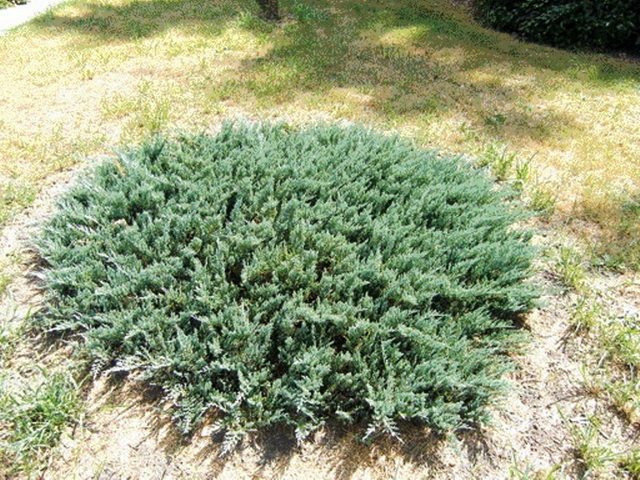

It is not recommended to use juniper-based products for pregnant women, as this can tone the uterus and provoke a miscarriage.
Landscape compositions with blue junipers
Juniper
30.07.2018
4 minutes
Juniper is one of the oldest plant species on Earth. Its varieties grow in areas from the tropics to the Arctic Circle. The culture can be in the form of a tree or a creeping bush.
Its diversity, combined with a magnificent appearance, has become the reason for the widespread use of the Cypress family in landscape design.
One of these is the Blue Arrow Rocky Juniper, a columnar variety recognized as the most decorative.
In terms of its parameters, this species is close to the Virginia juniper. Their main difference is that Skalny has thinner and tougher branches, due to which it keeps its shape better. The characteristics and description of Blue Arrow are given in the table.
| Parameters | Value |
| Plant type | Columnar coniferous tree |
| Height | By the age of 10, 2-3 m. Often trees grow up to 5 m or more |
| Needles | Soft, scaly, bluish in color |
| Fruit | Dark blue cone berries, globular |
Unlike many other varieties of juniper, Blue Arrow shoots grow almost from the ground itself, which makes it more attractive for use in landscaping.
Blue Arrow junipers are planted for decorative purposes - one by one as an architectural accent, in a group, and also in a row when creating hedges.
When choosing a planting site, it must be borne in mind that the tree does not like winds, especially hot ones. It should be planted in protected areas. It is undemanding to the composition of the soil, although it is preferable if it has neutral acidity.
The Blue Arrow juniper is not an antagonist and perfectly tolerates the neighborhood with other crops - both deciduous and coniferous. It should be borne in mind that when planting as a hedge, close planting forces the plants to compete with each other.
A special cover made of covering material, which is put on young plants, will help to protect the branches from kinking under the weight of precipitation.
DETAILS: Scabbard on indoor plants, how to fight?
In its absence, the crown can simply be pulled tighter with twine or rope.
Blue Arrow juniper is planted with seedlings. This is done either in early spring or in autumn. Its shoots are sold in containers, so they are moved into the hole along with a lump of earth. Planting pits are prepared in such a way that an earthen lump on the roots is placed there with a margin.
Caring for planted plants of this species is easy. Blue Arrow juniper is drought tolerant and does not need watering.
Despite this, regular irrigation will not harm it and will have a beneficial effect on the quality of the crown. Top dressing is done only in the spring.
To do this, most often use a nitrophosphate, scattering it on damp ground. If the soil is fertile enough, it is not necessary to feed it.
For self-cultivation of Skalny juniper, it is advisable to use the seed or vegetative method. The second is faster and preferred. To do this, cut the cuttings in the spring, clean them by 3 cm and immediately plant them in a nutritious soil.
As a rule, there are no problems with rooting. In winter, young plants are kept at home, and in spring they are planted in a permanent place.
Blue Arrow rocky juniper is rarely affected by diseases and pests. However, close proximity to fruit trees can lead to rust disease. Visually, it looks like a lot of red spots on the surface of the needles. The disease is dangerous, and if urgent measures are not taken, the culture is highly likely to die.
At the first detection of signs of rust, you need to do a complete inspection of the tree, cut off the infected branches and burn them. Treat the crown of the juniper with Phytocide.
The Rocky Blue Arrow Juniper is not the only decorative variety of this amazing plant that has a blue color. These also include:
- Blue Chip.
- Blue Alps.
- Blue Carpet.
- Blue Danube and others.
All of them are successfully used in landscape design.
Video about Blue Arrow juniper.
The juniper juniperus scopulorum blue arrow is an evergreen shrub with a sharp tip and expressive blue needles. It belongs to the cypress family. Translated from English, the name of the plant means "Blue Arrow". Its usual height is two to three meters, but some specimens reach five meters in height. The width of the bush is only 70 cm.
It has tough, upright shoots that fit snugly against the trunk. They form a graceful arrow-shaped plant. The branches grow almost from the ground itself - this is one of the advantages of Blue Airrow. Over time, they do not die off, like most other conifers, but retain their attractive appearance for a very long time. The graceful shape of the plant does not change with age and under the influence of weather conditions.
Juniper Virginia Blue Arrow is an unpretentious plant, undemanding to the composition and moisture of the soil. Its advantages:
- good frost resistance, which allows you to grow juniper in the northern regions;
- good drought resistance;
- compact structure of the crown, thanks to which Blue Errow does not need frequent haircuts;
- juniper gets along well with other types of plants - deciduous and coniferous.
In wildlife, the tree can be found in the rocky areas of North America, Canada, Colombia. History does not know exactly where exactly this tree was first seen by the breeder E. Wolf, but it was thanks to him that the culture appeared in Russia in 1917. The tree still grows in the botanical garden of St. Petersburg.
- Blue Ange with a richer silvery undertone;
- Blue Heaven, notable for its short stature;
- Blue Saber of high frost resistance;
- Colorado Green with a characteristic green tint;
- Medora with small annual growth;
- Skyrocket with a wider crown.
These are the most common varieties recommended by modern landscape designers. All trees are resistant to different climatic conditions and do not grow to a height of more than three meters in ten years.
In the state of New Mexico, a rocky Moffat blue juniper was found, in the trunk of which about 1888 annual rings were counted.
In addition to its exceptional decorative qualities, the culture has many useful, even medicinal properties. Moreover, such advantages are endowed with needles, juniper berries, which have long been used in folk medicine for the treatment of various diseases.
Junipers are coniferous evergreens that have reached the peak of popularity among ornamental conifers in recent years. They are used to decorate almost every second site. And those gardeners who have not yet planted this shrub of the Cypress family would like to have it, but are afraid of difficulties in leaving.
In fact, decorative junipers have green, light green, yellow, silver, variegated and blue needles. The variety of shapes and colors does not make this shrub any more difficult to care for.The truth is that blue is the most beautiful of the shades, which makes the plant look noble and majestic and serves as the best decoration for the site.
Why are juniper plants with silvery-bluish needles considered the most popular?
- Firstly, they look original and can decorate any landscape composition. High decorativeness distinguishes these varieties from all the other numerous members of the family.
- Secondly, the blue juniper retains its decorative qualities all year round. On the white snow, the branches, as if covered with a bluish haze, look no worse than among summer greenery or an autumn riot of colors.
- Third, blue junipers have the widest range of uses. They can be used almost unlimitedly in the garden design of both private estates and public parks.
Blue juniper in landscape design
- landscaping of slopes;
- hedges;
- curb landings;
- solitary plantings on the lawn;
- decoration of rock gardens and rockeries;
- landing on the banks of artificial reservoirs.
If you decide to plant blue junipers in your area, start by choosing the right variety. To do this, you need to find out which of these plants belong to the blue juniper species.
Among the blue junipers there are stunted and tall, spreading and with a compact crown, ground cover and erect.
The versatility of the size and growth of different types of blue junipers allows these plants to be used for different purposes, including for cultivation in indoor conditions, in containers or in greenhouses.

